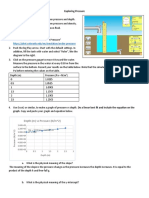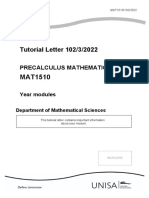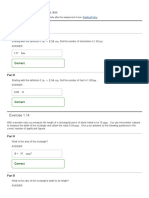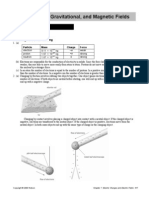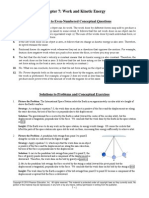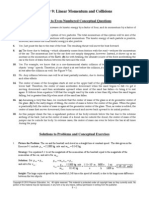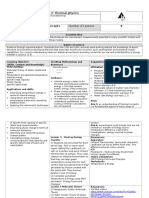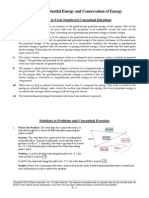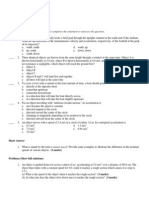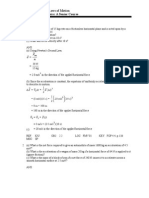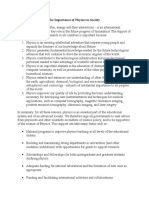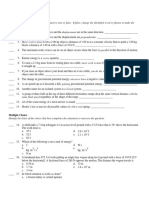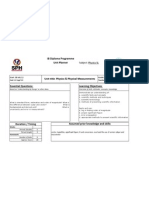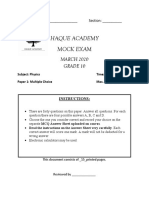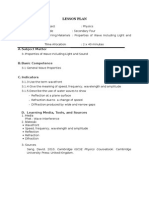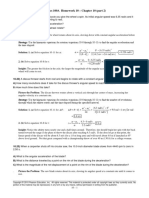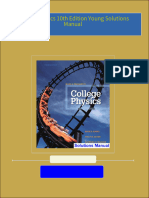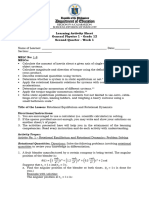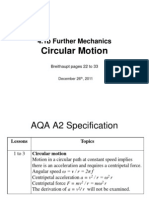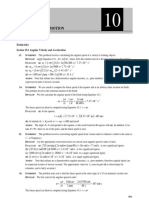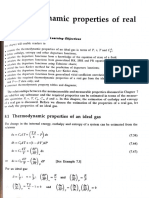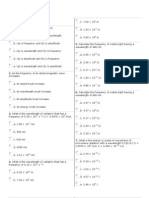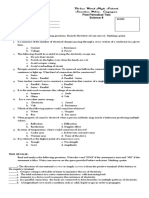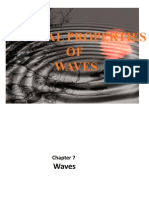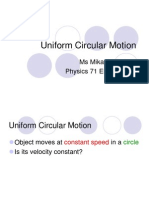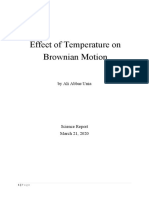Physics Chapter 10 Answers
Physics Chapter 10 Answers
Uploaded by
AbovethesystemCopyright:
Physics Chapter 10 Answers
Physics Chapter 10 Answers
Uploaded by
AbovethesystemCopyright
Share this document
Did you find this document useful?
Is this content inappropriate?
Copyright:
Physics Chapter 10 Answers
Physics Chapter 10 Answers
Uploaded by
AbovethesystemCopyright:
Chapter 10: Rotational Kinematics and Energy
Answers to Even-Numbered Conceptual Questions
2. 4. 6. Yes. In fact, this is the situation whenever you drive in a circular path with constant speed. Every point on Earth has the same angular speed. Therefore, the smallest linear speed occurs where the distance from the axis of rotation is smallest; namely, at the poles. The moment of inertia of an object changes with the position of the axis of rotation because the distance from the axis to all the elements of mass have been changed. It is not just the shape of an object that matters, but the distribution of mass with respect to the axis of rotation. Spin the two spheres with equal angular speeds. The one with the larger moment of inertiathe hollow spherehas the greater kinetic energy, and hence will spin for a longer time before stopping. (a) What determines the winner of the race is the ratio I mr 2 , as we see in the discussion just before
2 Conceptual Checkpoint 10-4. This ratio is MR 2 / MR 2 = 1 for the first hoop and ( 2 M ) R 2 / ( 2 M ) R = 1 for the
8. 10.
second hoop. Therefore, the two hoops finish the race at the same time. (b) As in part (a), we can see that the ratio I/mr2 is equal to 1 regardless of the radius. Thus, all hoops, regardless of their mass or radius, finish the race in the same time.
Solutions to Problems and Conceptual Exercises
1. Picture the Problem: This is a units conversion problem.
radians Strategy: Multiply the angle in degrees by to get radians. 180
Solution:
rad 30 = rad 180 6
rad 45 = rad 180 4
rad 90 = rad 180 2
rad 180 = rad 180
Insight: The quantity is the circumference of a circle divided by its diameter. = 3.1415926536 ... 2. Picture the Problem: This is a units conversion problem.
180 Strategy: Multiply the angle in radians by to get degrees. radians
Solution:
180 = 30 6
180 0.70 = 126
180 1.5 = 270
180 5 = 900
Insight: The quantity is the circumference of a circle divided by its diameter. = 3.1415926536 ... 3. Picture the Problem: The minute and hour hands of the clock rotate at constant angular speed. Strategy: Determine the time for each hand to complete a revolution. Multiply the revolutions per time by 2 radians per revolution and convert the time units to seconds to obtain an angular speed in radians/second. Solution: 1. (a) The minute hand completes a cycle once per hour: 2. (b) The hour hand completes two revolutions per day:
1 rev 2 rad 1 hr = 1.745 10 3 rad/s hr rev 3600 s
2 rev 2 rad 1 day 1 hr = 1.454 104 rad/s day rev 24 hr 3600 s
Insight: The angular speed of the hour hand is 12 times less than the angular speed of the minute hand because it completes a cycle once every 12 hours.
Copyright 2010 Pearson Education, Inc. All rights reserved. This material is protected under all copyright laws as they currently exist. No portion of this material may be reproduced, in any form or by any means, without permission in writing from the publisher.
10 1
Chapter 10: Rotational Kinematics and Energy
James S. Walker, Physics, 4th Edition
4.
Picture the Problem: The second hand completes one revolution every 60 seconds. Strategy: Multiply 1 rev 60 s by conversion factors to obtain the appropriate units. Solution: 1. (a) Convert the units: 2. (b) Convert the units: 3. (c) Convert the units:
1 rev 3600 s = 60 rev/h 60 s h
1 rev 60 s 360 deg = 360 deg/min 60 s min rev 1 rev 2 rad rad/s = 0.1047 rad/s = 60 s rev 30
Insight: Another common unit of angular speed is rev/min or rpm. The second hand rotates at 1.00 rev/min.
5.
Picture the Problem: This is a units conversion problem. Strategy: Convert the given angular speeds into units of rad/s and compare their magnitudes. Solution: 1. Find for the tire: 2. Find for the drill: 3. Find for the propeller:
tire =
2.00 103 deg rad = 34.9 rad/s s 180 deg 400.0 rev 2 rad 1 min = 41.89 rad/s min rev 60 s
drill =
prop = 40.0 rad/s
4. We can now rank the angular speeds from least to greatest: tire, propeller, drill Insight: In order to compare any quantities you must always ensure they have been measured in the same units.
6.
Picture the Problem: The tire rotates about its axis through a certain angle. Strategy: Use equation 10-2 to find the angular displacement. Solution: Solve equation 10-2 for :
s 1.95 m = = 5.9 rad r 0.33 m
Insight: This angular distance corresponds to 339 or 94% of a complete revolution.
7.
Picture the Problem: The Earth travels in a nearly circular path around the Sun, completing one revolution per year. Strategy: Convert the known angular speed of 1 rev/yr into units of rev/min. Solution: Convert the units:
1 rev 1 yr 1 day 1 h 6 = 1.90 10 rev/min yr 365 days 24 h 60 min
Insight: This angular speed corresponds to about 0.986 deg/day or 1.99107 rad/s. A good rule of thumb in astronomy is that the Sun appears to move 1/day against the background of the fixed stars.
8.
Picture the Problem: The Earth rotates once on its axis every 24 hours. Strategy: Convert the known angular speed of 1 rev/day into units of radians per second. Solution: Convert the units:
1rev 2 rad 1 day 1 h 5 = 7.27 10 rad/s day rev 24 h 3600s
Insight: This angular speed corresponds to about 15 / hour. A rule of thumb in astronomy is that the fixed stars will move across the sky at this rate (1 every 4 minutes, or 15 arcsec/s) due to Earths rotation.
9.
Picture the Problem: The pulsar rotates about its axis, completing 1 revolution in 0.33 s. Strategy: Divide one revolution or 2 radians by the period in seconds to find the angular speed. Solution: Calculate using equation 10-3:
2 rad 2 rad = = = 190 rad/s T t 0.033s
Insight: The rotation rate of the pulsar can also be described as 1800 rev/min.
Copyright 2010 Pearson Education, Inc. All rights reserved. This material is protected under all copyright laws as they currently exist. No portion of this material may be reproduced, in any form or by any means, without permission in writing from the publisher.
10 2
Chapter 10: Rotational Kinematics and Energy
James S. Walker, Physics, 4th Edition
10. Picture the Problem: The floppy disk rotates about its axis at a constant angular speed.
Strategy: Use equation 10-5 to relate the period of rotation to the angular speed. Then use equation 10-12 to find the linear speed of a point on the disks rim. Solution: 1. (a) Solve equation 10-5 for : 2. (b) Apply equation 10-12 directly:
2 2 = = 31.4 rad/s T 0.200s
vT = r = ( 1 3.5 in ) ( 31.4 rad/s ) = 55 in/s 1 m 39.4 in = 1.4 m/s 2
3. (c) A point near the center will have the same angular speed as a point on the rim because the rotation periods are the same. Insight: While the angular speed is the same everywhere on the disk, the linear speed is greatest at the rim. The read/write circuitry must compensate for the different speeds at which the bits of data will move past the head.
11. Picture the Problem: The propeller rotates about its axis with constant angular acceleration.
Strategy: Use the kinematic equations for rotating objects and the given formula to find the average angular speed and angular acceleration during the specified time intervals. By comparison of the formula given in the problem, = (125 rad/s ) t + ( 42.5 rad/s 2 ) t 2 ,with equation 10-10, = 0 + 0 t + 1 t 2 , we can identify 0 = 125 rad/s and 2
1 2
= 42.5 rad/s 2 .
2 0 t + 1 0 2 t 0 = = t t t (125 rad/s )( 0.010 s ) + ( 42.5 rad/s 2 ) ( 0.010 s )2 0 = 0.010 s av = 125 rad/s = 1.3 102 rad/s
Solution: 1. (a) Use equations 10-3 and 10-10 to find av :
av =
2. (b) Use equations 10-3 and 10-10 to find av :
2 2 1 0 = 0 t0 + 2 t0 = (125 rad/s )(1.000 s ) + ( 42.5 rad/s ) (1.000 s ) = 167.50 rad 0 169.60 167.50 rad = = = 210 rad/s = 2.1 102 rad/s av = 2
2 2 2 1 = 0 t + 2 t = (125 rad/s )(1.010 s ) + ( 42.5 rad/s ) (1.010 s ) = 169.60 rad
t t0
1.010 1.000 s
3. (c) Use equations 10-3 and 10-10 to find av :
2 2 2 1 0 = 0 t0 + 2 t0 = (125 rad/s )( 2.000 s ) + ( 42.5 rad/s ) ( 2.000 s ) = 420.00 rad 0 422.95 420.0 rad = = = 295 rad/s = 3.0 102 rad/s av =
2 2 2 1 = 0 t + 2 t = (125 rad/s )( 2.010 s ) + ( 42.5 rad/s ) ( 2.010 s ) = 422.95 rad
t t0
2.010 2.000 s
4. (d) The angular acceleration is positive because the angular speed is positive and increasing with time. 5. (e) Apply equation 10-6 directly: 6. Apply equation 10-6 directly:
av = av =
0
t
= =
210 125 rad/s = 85 rad/s 2 1.00 0.00 s 295 210 rad/s = 85 rad/s 2 2.00 1.00 s
0
t
Insight: We violated the rules of significant figures in order to report answers with two significant figures. Such problems arise whenever you try to subtract two large but similar numbers to get a small difference. The answers are only known to one significant figure, but we reported two in order to show clearly that the angular acceleration is constant. Of course, we could also have determined from the equation given in the problem that because 1 = 42.5 rad/s 2 , it must be true that = 85.0 rad/s 2 . 2
Copyright 2010 Pearson Education, Inc. All rights reserved. This material is protected under all copyright laws as they currently exist. No portion of this material may be reproduced, in any form or by any means, without permission in writing from the publisher.
10 3
Chapter 10: Rotational Kinematics and Energy
James S. Walker, Physics, 4th Edition
12. Picture the Problem: An object at rest begins to rotate with a constant angular acceleration.
Strategy: Use the kinematic equations for rotation (equations 10-8 through 10-11) to answer the conceptual question. Solution: Equation 10-10 indicates that for an object that starts from rest and then rotates with constant angular t 2 is proportional to the square of the time. We conclude that if the acceleration, the angular displacement = 1 2
object rotates through angle in time t then it rotates through angle 4 in time t 2.
Insight: Using similar reasoning we can determine the object will rotate through angle 9 in time 3t.
13. Picture the Problem: An object at rest begins to rotate with a constant angular acceleration.
Strategy: Use the kinematic equations for rotation (equations 10-8 through 10-11) to answer the conceptual question. Solution: Equation 10-8 indicates that for an object that starts from rest and then rotates with constant angular acceleration, the angular speed = t is linearly proportional to the time. We conclude that if the object has angular
speed after time t then its angular speed will be 2 at time t 2.
Insight: Using similar reasoning we can determine the object will rotate through angle 9 in time 3t.
14. Picture the Problem: The weight rises and slows down, coming to rest before falling downward once again.
Strategy: Use the kinematic equations for rotation (equations 10-8 through 10-11) to find the elapsed time. Solution: Solve equation 10-8 for t:
= 0 + t 0 5.0 5.40 rad/s = = 5.0 s t= 2.10 rad/s 2
Insight: The magnitude of will continue to increase until the mass hits the floor or the string runs out.
15. Picture the Problem: The wheel is given an initial angular velocity, slows down with constant angular acceleration, and eventually comes to rest.
Strategy: Use the kinematic equations for rotation (equations 10-8 through 10-11) to find the angle through which the wheel has rotated. The angular acceleration is given in the solution to Example 10-2 as = 0.736 rad/s 2 . Solution: Solve equation 10-11 for :
2 0 2 ( 2.45 rad/s ) ( 3.40 rad/s ) = 0 = = = 3.78 rad 2 2 ( 0.736 rad/s 2 )
2 2
Insight: This angle is 216 or 0.601 revolutions. The trick in the game is to set the initial angular velocity just right so that the wheel comes to rest after rotating through the correct angle to win the prize.
16. Picture the Problem: The propeller rotates about its axis, increasing its angular velocity at a constant rate.
Strategy: Use the kinematic equations for rotation (equations 10-8 through 10-11) to find the angular acceleration. Solution: Solve equation 10-11 for :
2 02 ( 26 rad/s ) (12 rad/s ) = = 17 rad/s 2 2 2 ( 2.5 rev 2 rad rev )
2
Insight: A speed of 26 rad/s is equivalent to 250 rev/min, indicating the motor is turning pretty slowly. A typical outboard motor is designed to operate at 5000 rev/min at full throttle.
17. Picture the Problem: The propeller rotates about its axis, increasing its angular velocity at a constant rate.
Strategy: Use the kinematic equations for rotation (equations 10-8 through 10-11) to find the angle through which the propeller rotated. Solution: Solve equation 10-9 for :
=
1 2
11 + 28 rad/s )( 2.4 s ) = ( 0 + ) t = 1 2(
47 rad = 7.4 rev
Insight: A speed of 28 rad/s is equivalent to 270 rev/min, indicating the motor is turning pretty slowly. A typical outboard motor is designed to operate at 5000 rev/min at full throttle.
Copyright 2010 Pearson Education, Inc. All rights reserved. This material is protected under all copyright laws as they currently exist. No portion of this material may be reproduced, in any form or by any means, without permission in writing from the publisher.
10 4
Chapter 10: Rotational Kinematics and Energy
James S. Walker, Physics, 4th Edition
18. Picture the Problem: The bicycle wheel rotates about its axis, slowing down with constant angular acceleration before coming to rest.
Strategy: Use the kinematic equations for rotation (equations 10-8 through 10-11) to find the angular acceleration and the time elapsed. Solution: 1. (a) Solve equation 10-11 for :
=
t=
02 ( 6.35 rad/s ) 2 0 2 = = 0.226 rad/s 2 2 ( 0 ) 2 (14.2 rev 2 rad rev )
2
2. (b) Solve equation 10-8 for t:
0 0 6.35 rad/s = = 28.1 s 0.226 rad/s 2
Insight: The greater the friction in the axle, the larger the magnitude of the angular acceleration and the sooner the wheel will come to rest.
19. Picture the Problem: The ceiling fan rotates about its axis, slowing down with constant angular acceleration before coming to rest.
Strategy: Use the kinematic equations for rotation (equations 10-8 through 10-11) to find the number of revolutions through which the fan rotates during the specified intervals. Because the fan slows down at a constant rate of acceleration, it takes exactly half the time for it to slow from 0.96 rev/s to 0.48 rev/s as it does to come to a complete stop. Solution: 1. (a) Apply equation 10-9 directly: 2. (b) Apply equation 10-9 directly:
= =
1 2 1 2
0 + 0.96 rev/s )( 2.4 min ( + 0 ) t = 1 2(
60 s min ) = 69 rev min ) = 52 rev
0.48 + 0.96 rev/s )(1.2 min 60 s ( + 0 ) t = 1 2(
Insight: Note that it takes half the time to slow to half speed, but the fan rotates through much more than half of its total of 69 revolutions during that time. An alternative way to solve the problem is to use = 0 t to find
= 0.0067 rev/s 2 and then use = 0 t + 1 t 2 to find for each of the specified intervals. Note that you can 2 stick with units of rev/s2 to find in units of revolutions instead of converting to radians and back again.
20. Picture the Problem: The discus thrower rotates about a vertical axis through her center of mass, increasing her angular velocity at a constant rate.
Strategy: Use the kinematic equations for rotation (equations 10-8 through 10-11) to find the number of revolutions through which the athlete rotates and the time elapsed during the specified interval. Solution: 1. (a) Solve equation 10-11 for :
= 0 = = 1.4 rev
2 0 2 ( 6.3 rad/s ) 02 = = 9.0 rad 1 rev 2 rad 2 2 ( 2.2 rad/s 2 )
2
2. (b) Solve equation 10-8 for t:
t=
0 6.3 0 rad/s = = 2.9 s 2.2 rad/s 2
Insight: Notice the athlete turns nearly one and a half times around. Therefore, she should begin her spin with her back turned toward the range if she plans to throw the discus after reaching 6.3 rad/s. If she does let go at that point, the linear speed of the discus will be about 6.3 m/s (for a 1.0 m long arm) and will travel about 4.0 m if launched at 45 above level ground. Not that great compared with a championship throw of over 40 m (130 ft) for a college woman.
Copyright 2010 Pearson Education, Inc. All rights reserved. This material is protected under all copyright laws as they currently exist. No portion of this material may be reproduced, in any form or by any means, without permission in writing from the publisher.
10 5
Chapter 10: Rotational Kinematics and Energy
James S. Walker, Physics, 4th Edition
21. Picture the Problem: The minute hand rotates faster than the hour hand, closing the angular gap between the two hands until the gap is 45.0.
Strategy: The hour and minute hands rotate at different rates. Use equation 10-3 to find expressions for the angular positions of the hour and minute hands as a function of time with 3:00 being the starting positions ( h,0 = 90.0 and m,0 = 0.0 ).
Set the angular positions difference equal to 45.0 and solve for t.
Solution: 1. Use equation 10-3 to find an expression for h m : 2. Find h and m :
m = m,0 + m t h = h,0 + h t h m = ( h,0 m,0 ) + (h m ) t
1 rev 1h 360 = 0.500 min 1 12.0 h 60 min rev 1 rev 360 m = = 6.00 min 1 60 min rev
h =
3. Solve the expression in step 1 for t:
t=
( h m ) ( h,0 m,0 ) ( 45.0 ) ( 90.0 ) = = 8.18 min ( h m ) ( 0.500 6.00 min 1 )
4. The two hands will be 45.0 apart 8.18 min after 3:00, or at 3:08:11. Insight: If you set the angular position difference to zero you find the two hands will be exactly aligned at 3:16:22.
22. Picture the Problem: The centrifuge rotates about its axis, slowing down with constant angular acceleration and coming to rest.
Strategy: Use the kinematic equations for rotation (equations 10-8 through 10-11) to find the angular acceleration and the number of revolutions through which the centrifuge rotates before coming to rest. Solution: 1. (a) Solve equation 10-8 for : 2. (b) Solve equation 10-9 for :
=
=
0
t
1 2
0 ( 3850 rev/min 1 min 60 s ) 10.2 s
= 6.29 rev/s 2
0 + 3850 rev/min 1 min ( + 0 ) t = 1 2(
60 s )(10.2 s ) = 327 rev
Insight: Another way of expressing the angular acceleration is to say that it slows down at a rate of 377 rev/min/s.
23. Picture the Problem: The Earth rotates on its axis, slowing down with constant angular acceleration.
Strategy: Equation 10-6 gives an expression for the angular acceleration as a function of rotation rate and time. Determine the difference in rotation rates between 1906 and 2006 by approximating T + T T because 0.840 s is tiny compared with the time (3.16107 s) it takes to complete 365 revolutions. Then use equation 10-6 to find the average angular acceleration over the 100 year time interval. Solution: 1. Find the difference in angular speeds:
0 =
T + T
T (T + T ) T = 2 + T T T T ( ) T
( 0.840 s ) = ( 365 rev 2 rad rev ) 2 ( 365 d )( 24 h/d )( 3600 s/h ) 0 = 1.94 1012 rad/s
2. Apply equation 10-6 directly:
av =
1.94 1012 rad/s = = 6.14 1022 rad/s 2 t (100 y 3.16 107 s/y )
Insight: Your first instinct might be to find the angular speed in 1906 assuming a period of 24.000 hrs (7.272205217105 rad/s) and figure out the angular speed in 2006 (7.272205023105 rad/s), but as you can see, attempting to subtract these numbers requires us to ignore the rules for significant figures. Using the approximation outlined above allows us to avoid the subtraction problem and keep three significant figures.
Copyright 2010 Pearson Education, Inc. All rights reserved. This material is protected under all copyright laws as they currently exist. No portion of this material may be reproduced, in any form or by any means, without permission in writing from the publisher.
10 6
Chapter 10: Rotational Kinematics and Energy
James S. Walker, Physics, 4th Edition
24. Picture the Problem: The compact disk rotates about its axis, increasing its angular speed at a constant rate.
Strategy: Use the kinematic equations for rotation (equations 10-8 through 10-11) to find the average angular speed during the time interval and then the angle through which the disk spins during this interval. Solution: 1. (a) Find the average angular speed over the time interval and use equation 10-9 to find . 2. (b) Apply equation 10-9 directly:
=
1 2
310 + 0 rev/min )( 3.3 s ( + 0 ) t = 1 2(
1 min 60 s ) = 8.5 rev
Insight: An alternative way to solve the problem is to use equation 10-8 to find = 1.72 rev/s 2 and use in equation 10-11 to find = 7.8 rev for the specified interval. Note that you can stick with units of rev/s2 to find in units of revolutions instead of converting to radians and back again.
25. Picture the Problem: The saw blade rotates about its axis, slowing its angular speed at a constant rate until it comes to rest.
Strategy: Use the kinematic equations for rotation (equations 10-8 through 10-11) to find the angular acceleration of the saw blade and the angle through which the blade spins during this interval. Then use equation 10-2 to convert the angular distance to a linear distance. Solution: 1. (a) Solve equation 10-8 for : 2. (b) Use equation 10-9 to find : 3. Convert to s:
0
t
1 2
0 ( 4440 rev/min 1 min 60 s ) 2.50 s
= 29.6 rev/s 2
0 + 4440 rev/min )( 2.50 s 1 min ( + 0 ) t = 1 2(
60 s ) = 92.5 rev
s = r = ( 1 2 10.0 in 12 in/ft ) ( 92.5 rev 2 rad/rev ) = 242 ft
4. (c) The blade completes exactly 92.5 revolutions, so a point on the rim ends up exactly opposite of where it started. Its displacement is therefore one blade diameter or 10.0 in. Insight: If the blade had completed an integer number of revolutions, a point on the rim would end up exactly where it began and the displacement would be zero even though the distance it travels is hundreds of feet.
26. Picture the Problem: The drill bit rotates about its axis, increasing its angular speed at a constant rate.
Strategy: Use the kinematic equations for rotation (equations 10-8 through 10-11) to find the angular acceleration, average angular speed during the time interval, and the angle through which the drill bit spins during this interval. Solution: 1. (a) Solve equation 10-8 for : 2. (b) Use equation 10-9 to find :
0
t
1 2
( 350, 000 rev/min 1 min
2.1s
60 s ) 0
= 2.8 103 rev/s 2
350, 000 + 0 rev/min )( 2.1 s 1 min ( + 0 ) t = 1 2(
60 s )
= 6.1 103 rev
Insight: The angular acceleration could also be expressed as 1.7104 rad/s2. Note that the bit spins thousands of times during the 2.1 seconds it is coming up to speed. At full speed it spins over 12,000 times in 2.1 seconds!
27. Picture the Problem: Jason is a distance R from the axis of rotation of a merry-go-round and Betsy is a distance 2R from the axis.
Strategy: Use an understanding of rotational motion to answer the conceptual question. Solution: 1. (a) Although the linear speeds of Jason and Betsy are different, their angular speeds are the same because they both ride on the same merry-go-round. Because each completes one revolution in the same amount of time, the rotational period of Jason is equal to the rotational period of Betsy. 2. (b) The best explanation is III. It takes the same amount of time for the merry-go-round to complete a revolution for all points on the merry-go-round. Statements I and II are each false. Insight: Jason has a smaller linear speed vt = r and a smaller centripetal acceleration acp = r 2 than does Betsy.
Copyright 2010 Pearson Education, Inc. All rights reserved. This material is protected under all copyright laws as they currently exist. No portion of this material may be reproduced, in any form or by any means, without permission in writing from the publisher.
10 7
Chapter 10: Rotational Kinematics and Energy
James S. Walker, Physics, 4th Edition
28. Picture the Problem: Jason is a distance R from the axis of rotation of a merry-go-round and Betsy is a distance 2R from the axis. Strategy: Use an understanding of the connections between linear and rotational quantities to answer the conceptual question.
Solution: 1. (a) Find the ratio of angular speeds: 2. (b) Find the ratio of linear speeds: 3. (c) Find the ratio of centripetal accelerations:
Jason = =1 Betsy
vt, Jason vt, Betsy acp, Jason acp, Betsy
=
R 1 = 2R 2 R2 1 = 2 2R 2
Insight: Jason completes the same number of revolutions as does Betsy but travels half the linear distance.
29. Picture the Problem: You stand on the top floor of Taipei 101, which is anchored to a rotating Earth.
Strategy: Use an understanding of rotational motion to answer the conceptual question. Solution: 1. (a) Although your linear speed is larger when standing on the top floor (because you are located at a larger distance from the Earths axis of rotation), your angular speed is the same as that of the Earth. We conclude that your angular speed due to the Earths rotation is equal to your angular speed when you stand on the ground floor. 2. (b) The best explanation is I. The angular speed is the same at all distances from the axis of rotation. Statements II and III are each false. Insight: In reference to statement III, it is true that air spins faster near the center of a hurricane than it does at the outer edge of the storm, but such a storm is a complex arrangement of moving fluids and not a solid rotating object like the Earth or a merry-go-round. A new concept called angular momentum (chapter 11) can be used to explain the differential rotation rates in a hurricane.
30. Picture the Problem: The hour hand rotates about its axis at a constant rate. Strategy: Convert the angular speed of the tip of the hour hand into a linear speed by using equation 10-12.
Solution: Apply equation 10-12 directly:
1 rev 2 rad 1 h vt = r = ( 8.2 cm ) = 0.0012 cm/s = 12 m/s 12 h rev 3600 s
Insight: The tip of a minute hand travels much faster, not only because its angular speed is 12 times faster than the hour hand, but also because the minute hand is longer than the hour hand.
31. Picture the Problem: The two children sit in different places on the same merry-go-round, which is rotating about its axis at a constant rate.
Strategy: Find the angular speed of the children by dividing 2 radians (for a complete circle) by the time it takes to complete a revolution. Then use equation 10-12 together with the angular speed to find the linear speed. Solution: 1. (a) Apply equation 10-3 to find 1 and 2 : 2. (b) Apply equation 10-12 directly: 3. Apply equation 10-12 directly:
1 = 2 =
2 rad = 1.4 rad/s 4.5 s
vt1 = r11 = ( 2.0 m )(1.4 rad/s ) = 2.8 m/s vt2 = r22 = (1.5 m )(1.4 rad/s ) = 2.1 m/s
Insight: Child 1 experiences a greater linear speed and greater centripetal acceleration because he is at a larger radius.
32. Picture the Problem: The Frisbee rotates at a constant rate about its central axis. Strategy: Use equation 10-12 to find the angular speed from the knowledge of the linear speed and the radius.
Solution: Solve equation 10-12 for :
vt 3.7 m/s = 1 = 26 rad/s r 2 ( 0.29 m )
Insight: The rotation of a Frisbee produces its unique, stable flight characteristics.
Copyright 2010 Pearson Education, Inc. All rights reserved. This material is protected under all copyright laws as they currently exist. No portion of this material may be reproduced, in any form or by any means, without permission in writing from the publisher.
10 8
Chapter 10: Rotational Kinematics and Energy
James S. Walker, Physics, 4th Edition
33. Picture the Problem: The two horses are located at different places on the same carousel, which is rotating about its axis at a constant rate.
Strategy: Find the angular speed of the horses by dividing 2 radians (for a complete circle) by the time it takes to complete a revolution. Then use equation 10-12 together with the angular speed to find the linear speed. Solution: 1. (a) Apply equation 10-3 to find 1 and 2 : 2. Apply equation 10-12 directly: 3. (b) Apply equation 10-12 directly:
1 = 2 =
2 rad = 0.14 rad/s 45 s
vt1 = r11 = ( 2.75 m )( 0.14 rad/s ) = 0.38 m/s vt2 = r22 = (1.75 m )(1.4 rad/s ) = 0.24 m/s
Insight: The outer horse has a greater linear speed and greater centripetal acceleration because it is at a larger radius.
34. Picture the Problem: Jeff clings to a vine and swings along a vertical arc as depicted in the figure at right.
Strategy: Use equation 10-12 to find the angular speed from the knowledge of the linear speed and the radius. Use equation 6-15 to find the centripetal acceleration from the speed and the radius of motion. Solution: 1. (a) Solve equation 10-12 for :
vt 8.50 m/s = = 1.18 rad/s 7.20 m r
2
2. (b) Apply equation 6-15 directly:
v 2 ( 8.50 m/s ) = 10.0 m/s 2 acp = t = 7.20 m r
3. (c) The centripetal force required to keep Jeff moving in a circle is provided by the vine. Insight: The vine must actually do two things, support Jeffs weight and provide his centripetal force. That is why it is possible that the vine is strong enough to support him when he is hanging vertically but not strong enough to support him while he is swinging. Theres no easy way for him to find out without trying but he should wear a helmet!
35. Picture the Problem: Jeff clings to a vine and swings along a vertical arc as depicted in the figure at right.
Strategy: Use equation 10-13 to find Jeffs centripetal acceleration and equation 10-14 to find his tangential acceleration. Add these two perpendicular vectors to find the total acceleration. Solution: 1. Apply equation 10-13 directly:
acp = r 2 = ( 7.20 m )( 0.850 rad/s )
= 5.20 m/s 2
2
2. Apply equation 10-14 directly:
at = r = ( 7.20 m ) ( 0.620 rad/s 2 ) = 4.46 m/s 2
3. Add the two perpendicular vectors: 4. Find the angle :
a = acp 2 + at 2 =
( 5.202 m/s ) + ( 4.464 m/s )
2 2
2 2
= 6.85 m/s 2
= tan 1
2 acp 1 5.20 m/s = 49.4 = tan 2 4.46 m/s at
Insight: The angle will increase with Jeffs speed if his angular acceleration remains constant because acp depends on
the square of the tangential speed.
Copyright 2010 Pearson Education, Inc. All rights reserved. This material is protected under all copyright laws as they currently exist. No portion of this material may be reproduced, in any form or by any means, without permission in writing from the publisher.
10 9
Chapter 10: Rotational Kinematics and Energy
James S. Walker, Physics, 4th Edition
36. Picture the Problem: The compact disk rotates about its axis, increasing its angular speed at a constant rate.
Strategy: Find the angular acceleration of the disk using equation 10-8, and then find the tangential acceleration from equation 10-14. 0 ( 4.00 rev/s 2 rad rev ) 0 Solution: 1. (a) Solve equation 10-8 for : = = = 8.38 rad/s 2 t 3.00 s 2. Apply equation 10-14 directly:
at = r =
1 2
( 0.12 m ) (8.38 rad/s 2 ) =
0.503 m/s 2
3. (b) The tangential acceleration depends only on the rate of change of angular speed, not the particular value of the angular speed. Therefore, the tangential acceleration remains 0.503 m/s2 irregardless of the angular speed. Insight: In actual practice the CD player requires the motor to continuously change the angular speed of the disk. See problem 91 for details.
37. Picture the Problem: The compact disk rotates about its central axis at a constant angular speed.
Strategy: Use equation 10-12 to find the linear speed of a point on the outer rim of the CD, and then use equation 10-13 to find the centripetal acceleration. Use ratios to determine the linear speed and centripetal acceleration for a point that is half the distance to the rotation axis. Solution: 1. (a) Apply equation 10-12 directly: 2. (b)Apply equation 10-13 directly: 3. (c) Use a ratio to find the new linear speed: 4. Use a ratio to find the new acp :
vt = r =
1 2
( 0.120 m )( 5.05 rad/s ) =
1 2
0.303 m/s = 1.53 m/s 2
acp = r 2 =
( 0.120 m )( 5.05 rad/s )
r 1 v2 r2 1 = = 2 = v2 = 1 v = 2 1 v1 r1 r 2
1 2
( 0.303 m/s ) =
1 2 2
0.152 m/s
2
r 1 a2 r2 2 1 = = 2 = a2 = 1 a = 2 1 2 a1 r1 r 2
(1.53 m/s ) = 0.765 m/s
Insight: The angular velocity is the same for all points on the CD regardless of the distance to the rotation axis.
38. Picture the Problem: The reel rotates about its axis at a constant rate. Strategy: Calculate the linear speed of the string from the radius of the reel and the angular speed.
Solution: 1. (a) Apply equation 10-12 directly:
3.0 rev 2 rad vt = r = ( 3.7 cm ) = 0.70 m/s s rev
2. (b) If the radius of the reel were doubled but the angular speed remained the same, the linear speed would also double as can be seen by an examination of equation 10-12. Insight: If the fish grabbed the lure when there was 10 m of string between it and the reel, it will take 14 seconds to reel in the big one.
39. Picture the Problem: The Ferris wheel rotates at a constant rate, with the centripetal acceleration of the passengers always pointing toward the axis of rotation. The acceleration of the passenger is thus upward when they are at the bottom of the wheel and downward when they are at the top of the wheel. Strategy: Use equation 10-13 to find the centripetal acceleration. The centripetal acceleration remains constant (as long as the angular speed remains the same) and points toward the axis of rotation.
Solution: 1. (a) Apply equation 10-13 directly:
2 rad 2 acp = r 2 = ( 9.5 m ) = 0.29 m/s 36 s
2
2. When the passenger is at the top of the Ferris wheel, the centripetal acceleration points downward toward the axis of rotation. 3. (b) The centripetal acceleration remains 0.29 m/s2 for a passenger at the bottom of the wheel because the radius and angular speed remain the same, but here the acceleration points upward toward the axis of rotation. Insight: In order to double the centripetal acceleration you need to increase the angular speed by a factor of 2 or decrease the period by a factor of 2 . In this case a period of 25 seconds will double the centripetal acceleration.
Copyright 2010 Pearson Education, Inc. All rights reserved. This material is protected under all copyright laws as they currently exist. No portion of this material may be reproduced, in any form or by any means, without permission in writing from the publisher.
10 10
Chapter 10: Rotational Kinematics and Energy
James S. Walker, Physics, 4th Edition
Top of Ferris Wheel
40. Picture the Problem: The Ferris wheel rotates clockwise but is slowing down at a constant rate. The Ferris wheel has a radius of 9.5 m and rotates once every 36 s.
G at
Strategy: Find the tangential acceleration of the passenger at the top of the Ferris wheel and combine it with the centripetal acceleration to find the total acceleration.
G a
G acp
r
G v
Solution: 1. Use equation 10-13 to find acp : 2. Use equation 10-14 to find at : 3. (c) Combine the components to find a : 4. (d) Find the angle and relate it to the direction of motion (which is to the right):
2 rad 2 acp = r 2 = ( 9.5 m ) = 0.29 m/s (downward) 36 s
at = r = ( 9.5 m ) ( 0.22 rad/s 2 ) = 2.1 m/s 2 (to the left)
2 a = acp + at2 =
( 0.29 m/s ) + ( 2.1 m/s )
2 2
2 2
= 2.1 m/s 2
2 acp 1 0.29 m/s = tan 2 2.1 m/s at direction of motion.
= tan 1
= 7.9 or 172 below the
Insight: In this case the tangential acceleration is 7.2 times greater than the centripetal acceleration. The passengers will notice the slowing down more than they noticed the centripetal acceleration when it was rotating at a constant rate.
41. Picture the Problem: The ball moves in a circle of constant radius at constant speed.
Strategy: The motion is approximately horizontal so we can neglect the fact that the rope would be inclined a little bit below horizontal in order to support the weight of the ball. Set the rope tension equal to the centripetal force required to keep the ball moving in a circle and solve for the angular speed. Solution: 1. (a) Set the string force F = macp and solve for :
F = macp = mr 2
F = mr
11 N = 2.2 rad/s ( 0.52 kg )( 4.5 m )
2. (b) Because is inversely proportional to r, the maximum angular velocity will increase if the rope is shortened. Insight: This is a fairly weak rope, since 11 N is only 2.5 lb. Still, the problem illustrates well how the centripetal force increases linearly with the distance from the rotation axis. Decreasing r decreases the force, or allows a higher for the same amount of force.
42. Picture the Problem: The sanding disk rotates about its axis at a constant rate.
Strategy: Convert the angular speed of the disk into the linear speed of its rim by multiplying by its radius (equation 10-12). Use the same equation together with equation 10-5 to determine the period of rotation for the given rim speed. Solution: 1. (a) Apply equation 10-12 directly: 2. (b) Substitute = 2 T and solve for T:
vt = r = ( 0.00320 m ) ( 2.15 10 4 rad/s ) = 68.8 m/s
vt = r = 2 r T T=
2 r 2 ( 0.00320 m ) = = 7.31 105 s = 73.1 s vt 275 m/s
Insight: An angular speed of 2.15104 rad/s is equivalent to 205,000 rev/min, or 3420 rev/s! Such high speeds are necessary to get the linear speed of the rim of such a small tool up to a value where it polishes well.
Copyright 2010 Pearson Education, Inc. All rights reserved. This material is protected under all copyright laws as they currently exist. No portion of this material may be reproduced, in any form or by any means, without permission in writing from the publisher.
10 11
Chapter 10: Rotational Kinematics and Energy
James S. Walker, Physics, 4th Edition
43. Picture the Problem: The sanding disk rotates about its axis, increasing its angular velocity at a constant rate.
Strategy: Use equation 10-14 to find the tangential acceleration and 10-13 to find the centripetal acceleration of a point on the rim of the disk. Solution: 1. Apply equation 10-14 directly: 2. Apply equation 10-13 directly:
at = r = ( 0.00320 m ) ( 232 rad/s 2 ) = 0.742 m/s 2 acp = r 2 = ( 0.00320 m )( 640 rad/s ) = 1300 m/s 2 = 1.3 km/s 2
2
Insight: The centripetal acceleration is very much greater than the tangential acceleration for a point on the rim, or any
other point for that matter! The two are equal only when = 232 rad/s 2 = 15.2 rad/s. Note that there are only two significant figures in step 2 because of the ambiguity in the value 640 rad/s. 44. Picture the Problem: The electron moves along a circular path at constant speed.
Strategy: Use equation 10-12 to convert the linear speed into an angular speed. Convert that angular speed to units of revolutions per second to answer the question in part (b). Then use equation 10-13 to find the centripetal acceleration. Solution: 1. (a) Solve equation 10-12 for : = 2. (b) Convert to rev/s: 3. (c) Apply equation 10-13 directly:
vt 2.18 106 m/s = = 4.12 1016 rad/s r 5.29 10 11 m
= ( 4.12 1016 rad/s ) (1 rev 2 rad ) = 6.56 1015 rev/s = 6.56 1015 orbits
acp = r 2 = ( 5.29 10 11 m )( 4.12 1016 rad/s ) = 8.98 10 22 m/s 2
2
Insight: The electron is traveling at 0.727% the speed of light in this classical model. In the quantum mechanical model it is not moving at all, even though it has momentum! More amazing facts about quantum mechanics are in Chapter 30.
45. Picture the Problem: The wheel rotates about its axis, increasing its angular velocity at a constant rate.
Strategy: Set the tangential (equation 10-14) and centripetal (equation 10-13) accelerations equal to each other for a single point on the rim. Find an expression for the angular speed as a function of time using equation 10-8 ( 0 = 0 because the wheel starts from rest), and substitute the expression into the result of the first step. Then solve the equation for t. Solution: 1. Set at = acp : 2. Substitute = 0 + t and solve for t:
at = r = r 2 = acp = 2
= ( t ) = 2 t 2
2
= t2 t =
Insight: The greater the angular acceleration, the shorter the elapsed time before the angular and centripetal accelerations equal each other. After that the centripetal acceleration dominates because it is proportional to 2 .
46. Picture the Problem: As you drive down the highway, the top of your tires are moving with a speed v.
Strategy: Note the discussion surrounding figures 10-10 and 10-11, which show that the top of a wheel (that is rolling without slipping) is moving twice as fast as the center of the wheel. Solution: The reading on the speedometer gives the speed of the axles of your car. This is the same as the speed of the occupants inside the car. If the top of the tires have a speed v, the axles have a speed v 2 . Insight: If the tires spin freely, as when the car is stuck in snow, the rim of the tire is moving at high speed while the axle is at rest.
Copyright 2010 Pearson Education, Inc. All rights reserved. This material is protected under all copyright laws as they currently exist. No portion of this material may be reproduced, in any form or by any means, without permission in writing from the publisher.
10 12
Chapter 10: Rotational Kinematics and Energy
47. Picture the Problem: The tires roll without slipping at constant speed.
James S. Walker, Physics, 4th Edition
Strategy: Because the tires roll without slipping, equation 10-15 describes the direct relationship between the center of mass speed and the angular velocity of the tires. Solve the equation for the angular velocity. Solution: Solve equation 10-15 for :
vt 15 m/s = = 48 rad/s r 0.31 m
Insight: If the tires spin freely, as when the car is stuck in snow, the center of mass speed can be zero while the angular velocity is very high.
48. Picture the Problem: The drive wheel of the tricycle rolls without slipping at constant speed.
Strategy: Because the wheel rolls without slipping, equation 10-15 describes the direct relationship between the center of mass speed and the angular velocity of the driving wheel. Solution: Apply equation 10-15 directly:
vt = r = ( 0.260 m )( 0.373 rev/s 2 rad rev ) = 0.609 m/s
Insight: This speed corresponds to about 1.4 mi/h, half the normal walking speed of an adult. The larger wheels on adult bicycles allow for higher linear speeds for the same angular speed of the driving wheel.
49. Picture the Problem: A soccer ball rolls without slipping at constant speed.
Strategy: Use the known circumference of the ball to determine its radius, and use the distance and time information to find its center of mass velocity. Combine the two quantities using equation 10-15 to find the angular speed of the ball. Solution: 1. Find r from the circumference: 2. Determine the velocity: 3. Solve equation 10-15 for :
r= C 0.700 m = = 0.1114 m 2 2
v=
x (14.0 yd )( 3 ft yd )(1 m 3.281 ft ) = = 3.82 m/s 3.35 s t
v 3.82 m/s = = 34.3 rad/s r 0.1114 m
Insight: The ball travels about 8.55 mi/h. The reason we can determine its angular speed is because it rolls without slipping. If it is kicked very hard, it will fly through the air, spinning freely, and there would be no relationship between its angular and center-of-mass velocities. We bent the rules for significant figures in step 1 to avoid rounding error.
50. Picture the Problem: Your cars tires roll without slipping, increasing their velocity at a constant rate.
Strategy: Use the fact that the tires roll without slipping to find the angular acceleration and angular velocity from their linear counterparts. Then use the kinematic equations for rotation (equations 10-8 through 10-11) to determine the angle through which the tire rotated during the specified interval. Solution: 1. Solve equation 10-12 for 0 : 2. Solve equation 10-14 for : 3. Apply equation 10-10 directly:
0 =
=
v0 17 m/s = = 52 rad/s r 0.33 m
a 1.12 m/s 2 = = 3.4 rad/s 2 r 0.33 m
2
= 0 t + 1 t 2 = ( 52 rad/s )( 0.65 s ) + 1 3.4 rad/s 2 ) ( 0.65 s ) 2 2(
= 35 rad = 5.5 rev
1 2
Insight: Another way to solve this question is to find the final angular speed (54 rad/s) and then use =
find the answer.
( + 0 ) t
to
Copyright 2010 Pearson Education, Inc. All rights reserved. This material is protected under all copyright laws as they currently exist. No portion of this material may be reproduced, in any form or by any means, without permission in writing from the publisher.
10 13
Chapter 10: Rotational Kinematics and Energy
James S. Walker, Physics, 4th Edition
51. Picture the Problem: The bicycle tire rolls without slipping, increasing its angular speed at a constant rate. Strategy: Because the tire rolls without slipping there is a direct relationship between its linear and angular acceleration (equation 10-14). Use that equation together with the definition of acceleration (equation 3-5) to determine the angular acceleration. (8.90 0 m/s ) a 1 v Solution: 1. (a) Solve equation 10-14 for : : = = 2.03 rad/s 2 = = r r t ( 0.360 m )(12.2 s )
2. (b) If the radius of the tires had been smaller, the angular acceleration would have been greater than 2.03 rad/s2. Insight: The linear acceleration in this case is 0.730 m/s2. If the bike were sliding without friction down an incline, we could say its acceleration equals g sin and the slope must be = 4.26. However, because the tire rolls we must take torque and moment of inertia into account (see Chapter 11). If we do so we find would still be 4.26 for a hoopshaped wheel but only 2.13 if the wheel were a solid disk.
52. Picture the Problem: The minute hand of a clock is long, thin, and uniform; and the hour hand is short, thick, and uniform. Each hand has the same mass and the same axis of rotation. Strategy: Apply the concept of moment of inertia to answer the conceptual question. Solution: 1. (a) The moment of inertia of any object depends upon its total mass as well as the distribution of that mass in relation to the axis of rotation. Because I = mi ri 2 , the farther the mass is located from the axis of rotation, the larger the moment of inertia. Because the mass of the longer minute hand is located farther from its axis of rotation, we conclude that the moment of inertia of the minute hand is greater than the moment of inertia of the hour hand.
2. (b) The best explanation is II. Having mass farther from the axis of rotation results in a greater moment of inertia. Statements I and III are each false. Insight: If the hour hand were much more massive than the minute hand, it could have a larger moment of inertia than the minute hand even though it is shorter. In general, the moment of inertia of a thin, uniform rod of mass M and length L that pivots about one of its ends is 1 M L2 . 3
53. Picture the Problem: Tons of dust and small particles rain down onto the Earth from space every day. Strategy: Apply the concept of moment of inertia to answer the conceptual question.
Solution: 1. (a) The moment of inertia I = mi ri 2 of any object depends upon its total mass as well as the distribution
of that mass in relation to the axis of rotation. Even though the radius of the Earth does not increase appreciably due to space dust, its total mass does increase a little bit. We conclude that the Earths moment of inertia does increase due to the accumulation of the space dust. 2. (b) The best explanation is I. The dust adds mass to the Earth and increases its radius slightly. Statement II would only be true if the dust were connected to the Earth somehow as it fell toward the planet. However, the falling dust is not connected to the Earth and does not contribute to the Earths moment of inertia until it lands. Statement III is false. Insight: The mass gain from space dust is a tiny fraction of the Earths mass. The Earth gains about 20,000 tons of dust per year, or approximately a 31016 % annual gain in mass. 54. Picture the Problem: A bicycle wheel is rotated about an axis through its rim and parallel to its axle. Strategy: Apply the concept of moment of inertia to answer the conceptual question.
Solution: 1. (a) The moment of inertia I = mi ri 2 of any object depends upon its total mass as well as the distribution
of that mass in relation to the axis of rotation. When the bicycle wheel is rotated about an axis that passes through its rim, an appreciable fraction of its mass is located at a distance farther than one radius from the axis. We conclude that its moment of inertia about this axis is greater than its moment of inertia about its axle.
2. (b) The best explanation is III. Mass is farther from the axis when the wheel is rotated about the rim. Statement I is false and statement II is true, but irrelevant. Insight: You can observe the change in moment of inertia by first attempting to spin a bicycle wheel about its axle. Then place your finger just inside the rim and attempt to rotate the wheel about your finger, a little bit like a hoola hoop. Youll notice that it is much more difficult to spin the wheel in the second case due to the larger moment of inertia.
Copyright 2010 Pearson Education, Inc. All rights reserved. This material is protected under all copyright laws as they currently exist. No portion of this material may be reproduced, in any form or by any means, without permission in writing from the publisher.
10 14
Chapter 10: Rotational Kinematics and Energy
James S. Walker, Physics, 4th Edition
55. Picture the Problem: The bicycle wheel is assumed to have the shape of an ideal hoop.
Strategy: Use the known moment of inertia of a hoop ( I = MR 2 ) to find the radius of the wheel. Solution: Solve I = MR 2 for R:
R= I 0.13 kg m 2 = = 0.36 m 0.98 kg M
Insight: This wheel would have a 0.72 m diameter or 28 inches. This is a bit bigger than the standard 26 inch or 0.66 m bicycle tire.
56. Picture the Problem: The grindstone is a solid disk that rotates about its axis at constant angular speed. Example 10-4 indicates that its moment of inertia is 4.30 kgm2.
Strategy: Find the angular speed from the rotation period and then use the known moment of inertia and equation 10-17 to find the kinetic energy. Solution: Apply equation 10-17 directly:
K=1 I 2 = 2
1 2
2 rad ( 4.30 kg m2 ) = 4.81 J 4.20 s
Insight: The angular speed of the disk is a gentle 14.3 rev/min, a fairly easy speed to maintain even with a foot-powered grindstone. However, the 0.913 m/s linear speed of the rim of the grindstone isnt very effective at grinding axes!
57. Picture the Problem: The fan blade rotates about its axis with a constant angular speed.
Strategy: Use equation 10-17 for the kinetic energy of a rotating object to solve for the moment of inertia. Solution: Solve equation 10-17 for I:
I=
2K
2 ( 4.6 J )
(13 rad/s )
= 0.054 kg m 2
Insight: If the angular speed of the fan blade were to double to 24 rad/s, the kinetic energy would quadruple to 16 J.
58. Picture the Problem: The hoop rolls without slipping on a horizontal surface at constant speed. Using the data from Example 10-5, the hoop has a mass of 1.20 kg, a radius of 10.0 cm, and a linear speed of 1.41 m/s.
Strategy: Find the translational kinetic energy using equation 7-6 and the rotational kinetic energy using equation 1017. Then add the two energies to find the total kinetic energy. Solution: 1. (a) Apply equation 7-6 directly: 2. (b) Apply equation 10-17 directly: 3. (c) Add the two energies:
Kt = 1 mv 2 = 2 Kr = 1 I 2 = 2
1 2 1 2
(1.20 kg )(1.41 m/s )
= 1.19 J
2
( mr )
2
=1 mr 2 ( v r ) = 1 mv 2 = 1.19 J 2 2
2
K = Kt + Kr = 2 1 mv 2 = (1.20 kg )(1.41 m/s ) = 2.39 J 2
Insight: If we simply added 1.19 + 1.19 J = 2.38 J in part (c) we wouldve introduced some rounding error. Note that exactly half of the hoops kinetic energy is translational and half is rotational, whereas in the Example 10-5, two-thirds of the disks kinetic energy was translational and one-third rotational.
Copyright 2010 Pearson Education, Inc. All rights reserved. This material is protected under all copyright laws as they currently exist. No portion of this material may be reproduced, in any form or by any means, without permission in writing from the publisher.
10 15
Chapter 10: Rotational Kinematics and Energy
59. Picture the Problem: The L-shaped object in the figure at right can be rotated in one of the following three ways: case 1, rotation about the x axis; case 2, rotation about the y axis; and case 3, rotation about the z axis (which passes through the origin perpendicular to the plane of the figure).
James S. Walker, Physics, 4th Edition
Strategy: The moment of inertia of any object depends upon its total mass as well as the distribution of that mass in relation to the axis of rotation. Because I = mi ri 2 , the farther the mass is located from the axis of
rotation, the larger the moment of inertia. Calculate the moment of inertia for each of the three cases in order to determine the ranking.
Solution: 1. Find I for case 1: 2. Find I for case 2: 3. Find I for case 3:
I1 = mi ri 2 = ( 9.0 kg )(1.0 m ) = 9.0 kg m 2
2
I 2 = mi ri 2 = ( 2.5 kg )( 2.0 m ) = 10 kg m 2
2
I 3 = mi ri 2 = ( 9.0 kg )(1.0 m ) + ( 2.5 kg )( 2.0 m ) = 19 kg m 2
2 2
4. By comparing the above calculations we arrive at the ranking I1 < I2 < I3 . Insight: Whenever the axis of rotation passes through the center of mass of an object, that object makes no contribution to the moment of inertia about that axis because r = 0.
60. Picture the Problem: The compact disk rotates about its central axis at a constant angular speed.
Strategy: First find the moment of inertia of the CD, modeling it as a uniform disk. Then find the kinetic energy using equation 10-17. Finally, use a ratio to find the new angular speed that would double the rotational kinetic energy. Solution: 1. (a) Apply equation 10-17 MR 2 for the CD: directly, using I = 1 2 2. (b) Use a ratio to find the new :
K=1 I 2 = 2 =
1 4 1 2
1 2
MR 2 ) 2
2 2
( 0.012 kg )( 0.060 m ) ( 34 rad/s )
= 0.012 J = 12 mJ
2 K new I K new 2 K old new = = = = 2 K K old old 2 K old I old
new = 2old = 2 ( 34 rad/s ) = 48 rad/s
Insight: A speed of 48 rad/s corresponds to 460 rev/min, typical for a music CD player. Computer CD-ROM drives and DVD drives can spin the disk at a much faster rate.
61. Picture the Problem: The ball rotates about its center with a constant angular velocity.
Strategy: Use equation 7-6 to find the translational kinetic energy and equation 10-17 to find the rotational kinetic energy of the curveball. Solution: 1. Apply equation 7-6 directly:
2 2. Use I = 5 MR 2 for a uniform sphere
Kt = 1 Mv 2 = 2 Kr = 1 I 2 = 2 =
1 5
1 2 1 2
( 0.15 kg )( 48 m/s )
= 170 J
2 5
MR 2 ) 2 = 1 MR 2 2 5
2 2
in equation 10-17:
( 0.15 kg )( 0.037 m ) ( 42 rad/s )
= 0.072 J
Insight: Only a tiny fraction of the total kinetic energy is used to spin the ball, but it has a marked effect on the trajectory of the pitch!
Copyright 2010 Pearson Education, Inc. All rights reserved. This material is protected under all copyright laws as they currently exist. No portion of this material may be reproduced, in any form or by any means, without permission in writing from the publisher.
10 16
Chapter 10: Rotational Kinematics and Energy
James S. Walker, Physics, 4th Edition
62. Picture the Problem: The basketball rolls without slipping at constant speed on the level floor.
Strategy: Use equation 10-17 and the moment of inertia of a hollow sphere to find the rotational kinetic energy of the ball. Then use equation 7-6 to find the translational kinetic energy, and sum the two to find the total kinetic energy. Use a ratio to find out what fraction of the balls energy is rotational kinetic energy. Solution: 1. (a) Apply equations 10-17 and 7-6 to find K r , K t , and the total K:
Kr = 1 I 2 = 2
1 2
2 3
MR 2 ) ( v R ) = 1 Mv 2 3
2
Kt = 1 Mv 2 2 K = Kr + Kt = 1 Mv 2 + 1 Mv 2 = 5 Mv 2 3 2 6
2 Kr 1 2 3 Mv = 5 = 2 K Mv 5 6
2. Calculate the ratio K r K :
3. (b) The answer to part (a) will stay the same if the linear speed of the ball is doubled to 2v, because the ratio is independent of speed, radius, and mass. Insight: The ratio is a constant because when an object rolls without slipping there is a direct relationship between its translation and rotation: vt = r .
63. Picture the Problem: The Earth rotates on its axis, slowing down with constant angular acceleration.
Strategy: Determine the difference in rotation rates over the span of a century by approximating T + T T because 0.0023 s is tiny compared with the time (86,400 s) it takes to complete one revolution. Then use equation 10-6 to find the average angular acceleration over the 100-year time interval. Solution: 1. Find the difference in angular speeds:
0 =
T + T
T (T + T ) T = 2 + T T T T ( ) T
( 0.840 s ) = ( 365 rev 2 rad rev ) 2 ( 365 d )( 24 h/d )( 3600 s/h ) 0 = 1.94 1012 rad/s
2. Find the sum of the angular speeds:
+ 0 =
T + T
T + (T + T ) 2T + T = 2 T T T (T + T )
2 T
3. Multiply the results of steps 1 and 2: 4. Find the difference K r over a time interval of 100 years:
( 0 )( + 0 ) = 2 02 =
T 2 2 2 T = T 2 T T3
2 2 T I 2 T 2 2 2 2 1 1 1 K r = 1 = = = I I I I ( ) 0 0 2 2 2 2 T3 T3 2 2 0.331 M E RE T = 3 T =
0.331( 5.97 1024 kg )( 6.38 106 m ) ( 2 ) ( 0.0023 s )
2 2
(86,400 s )
= 1.1 1022 J
5. Use equation 7-10 to find the energy loss rate (power):
P=
W 1.1 1022 J = = 3.5 1012 W = 3.5 TW t 100 y 3.16 107 s/y
Insight: Your first instinct might be to find the angular speed a hundred years ago assuming a period of 24.000 hrs (7.272205217105 rad/s) and figure out the angular speed in 2006 (7.272205023105 rad/s), but as you can see, attempting to subtract these numbers requires us to ignore the rules for significant figures. Using the approximation outlined above allows us to avoid the subtraction problem and keep two significant figures. The huge energy loss is due primarily to tidal friction, as the ocean tides dissipate the kinetic energy of the Earths rotation into heat.
Copyright 2010 Pearson Education, Inc. All rights reserved. This material is protected under all copyright laws as they currently exist. No portion of this material may be reproduced, in any form or by any means, without permission in writing from the publisher.
10 17
Chapter 10: Rotational Kinematics and Energy
James S. Walker, Physics, 4th Edition
64. Picture the Problem: The lawn mower blade rotates at constant speed about its axis. Strategy: Find the rotational kinetic energy of the blade using equation 10-17, then set that energy equal to its gravitational potential energy and solve for ymax . Treat the blade as a uniform rod rotating about its center, so that its moment of inertia is
1 12
ML2 as indicated in Table 10-1.
Solution: 1. (a) Use equation 10-17 to find K r :
Kr = 1 I 2 = 2
1 24
1 2
1 12
ML2 ) 2
2 2
3500 rev 2 rad 1 min = ( 0.65 kg )( 0.55 m ) min rev 60 s K r = 1100 J = 1.1 kJ K r = U = mgymax K 1100 J = 173 m = 0.17 km ymax = r = mg ( 0.65 kg ) ( 9.81 m/s 2 )
2. (b) Set K r = U and solve for ymax :
Insight: 170 m is 570 ft straight up! The rotation rate is made to be so high in order that linear speed of the outside tip of the mower blade (100 m/s = 230 mi/h) is high enough to cleanly slice the blades of grass.
65. Picture the Problem: A ball is released from rest on the frictionless side of the curved surface depicted at right and comes to rest on the no-slip surface. Strategy: Apply the concepts discussed in Conceptual Checkpoint 10-5 to answer the question. Solution: In this case, all of the original gravitational potential energy is converted to translational kinetic energy when the ball reaches the bottom of the track. It then begins to spin as it skids on the no-slip surface until it rolls without slipping. This process dissipates some of the mechanical energy. The remaining mechanical energy is converted to gravitational potential energy, but because mechanical energy has been lost the height attained will be less. We conclude that when the ball comes to rest on the no-slip surface, its height is less than the height from which it was released. Insight: According to the discussion in Conceptual Checkpoint 10-5 the ball does not reach its initial height when it is released from the no-slip side, either, but for a different reason. In that case some of its mechanical energy is stored as rotational energy and in this case some of its mechanical energy is converted to thermal energy by friction.
66. Picture the Problem: The block rises upward, slows down, and comes to rest as the kinetic energy of the wheel and the block is converted into the blocks gravitational potential energy. Strategy: Use the formula from step 4 of Example 10-6 that was derived from conserving kinetic energy between the initial and final states. Solve the expression for the moment of inertia of the wheel.
Solution: 1. Write out the equation from step 4 of Example 10-6: 2. Solve the expression for I:
v2 I h= 1 + 2 2 g mR 2 gh I = mR 2 2 1 v
2 2 2 ( 9.81 m/s ) ( 0.074 m ) = 0.17 kg m 2 I = ( 2.1 kg )( 0.080 m ) 1 2 0.33 m/s ( ) Insight: If the wheel were massless the block would rise to a height of only 5.6 mm. This is because a substantial amount of energy is stored in the rotation of the massive wheel, and that energy can be used to lift the block much farther than if it had only its own kinetic energy to use.
3. Insert the numerical values:
Copyright 2010 Pearson Education, Inc. All rights reserved. This material is protected under all copyright laws as they currently exist. No portion of this material may be reproduced, in any form or by any means, without permission in writing from the publisher.
10 18
Chapter 10: Rotational Kinematics and Energy
James S. Walker, Physics, 4th Edition
67. Picture the Problem: The yo-yo falls straight down, increasing both its translational and rotational kinetic energy. The Active Example 10-3 indicates that the mass of the yo-yo is 0.056 kg, its moment of inertia is 2.9 105 kg m 2 ,and the radius r of the axle the string wraps around is 0.0064 m. Strategy: Use conservation of energy, including both translational and rotational kinetic energy, to determine the height h through which the yo-yo falls.
Solution: 1. Set Ei = Ef and simplify:
Ki + U i = K f + U f 0 + mgh = 1 mv 2 + 1 I 2 2 2 v2 I m+ 2 2mg r 2 ( 0.65 m/s )
mv 2 + 1 I v r) = 1 v2 ( m + I r 2 ) =1 2 2 ( 2
2
2. Solve for h:
h= =
2.9 10 5 kg m 2 0.056 kg + = 0.29 m 2 2 ( 0.056 kg ) ( 9.81 m/s 2 ) ( 0.0064 m ) Insight: Since the yo-yo fell 0.50 m in order to attain a speed of 0.85 m/s in the Active Example 10-3, we expect it will need to fall a shorter distance in order to attain a speed of only 0.65 m/s. Note that the distance of the fall is
2 2 vold proportional to the square of the speed, so that hnew = hold ( vnew ) = ( 0.50 m )( 0.65 m/s ) 2
( 0.85 m/s )
= 0.29 m.
68. Picture the Problem: Several disks of different masses and radii roll without slipping down the incline plane, starting from rest at height h above the level surface.
Strategy: Apply the concepts discussed in Conceptual Checkpoint 10-4 to determine the ranking of the three disks. Solution: In the discussion surrounding Conceptual Checkpoint 10-4 it was determined that the speed of a rolling object 2 gh at the bottom of an incline of height h is v = regardless of its . However, for any uniform disk I m r 2 = 1 2 1+ I m r2
mass or radius. We conclude that the speeds of the disks will be equal and the ranking of the order in which the three disks finish the race is disk 1 = disk 2 = disk 3.
Insight: Using a similar argument we can see that any uniform sphere will beat any uniform disk because for a uniform 2 regardless of the mass or radius of the sphere. sphere I m r 2 = 5
Copyright 2010 Pearson Education, Inc. All rights reserved. This material is protected under all copyright laws as they currently exist. No portion of this material may be reproduced, in any form or by any means, without permission in writing from the publisher.
10 19
Chapter 10: Rotational Kinematics and Energy
69. Picture the Problem: The disk and the hoop roll without slipping down the incline plane, starting from rest at height h above the level surface.
James S. Walker, Physics, 4th Edition
Strategy: Conserve mechanical energy, including both translational and rotational kinetic energy, in order to find the speeds of the objects at the bottom of the incline. Use equation 10-15 to relate the rotational speed to the linear speed of each object. Solution: 1. (a) Set Ei = Ef and let = v r :
mgh + 0 = 0 + 1 mv 2 + 1 I 2 = 1 mv 2 + 1 I v r) 2 2 2 2 (
1 mgh = 1 mv 2 + 1 mr 2 ) ( v r ) 2 2(2 2
U i + Ki = U f + Kf
2. For the disk I = 1 mr 2 : 2
gh = 1 v2 + 1 v2 = 3 v2 2 4 4 v=
4 3
gh =
4 3
( 9.81 m/s ) ( 0.82 m ) = 3.3 m/s
2 2
3. (b) For the hoop I = mr 2 :
mgh = 1 mv 2 + 1 mr 2 ) ( v r ) 2 2( gh = 1 v2 + 1 v2 = v2 2 2 v = gh =
2
( 9.81 m/s ) ( 0.82 m ) = 2.8 m/s
Insight: Note that the final speeds are independent of the masses and the radii of the objects. A disk will always beat a hoop as long as their centers of mass begin at the same height h above the level surface.
70. Picture the Problem: The larger mass falls and the smaller mass rises until the larger mass hits the floor.
Strategy: Use conservation of mechanical energy, including the rotational energy of the pulley, to determine the mass of the pulley. Because the rope does not slip on the pulley, there is a direct relationship v = rp between the rotation of the pulley
and the linear speed of the rope and masses.
Solution: 1. (a) Equate the initial and final mechanical energies, then solve for the mass of the pulley. 2. (b) Set Ei = Ef and let = v rp :
U i + Ki = U f + K f m1 gh + 0 + 0 = m2 gh + 1 m v2 + 1 m2 v 2 + 1 I 2 2 1 2 2 p
1 m + m2 ) v 2 + 1 mp rp 2 ) ( v ( m1 m2 ) gh = 1 2( 1 2(2
rp )
3. Rearrange the equation and solve for mp :
1 4
mp v 2 = ( m1 m2 ) gh 1 m + m2 ) v 2 2( 1
2 4 ( m1 m2 ) gh 1 2 ( m1 + m2 ) v mp = 2 v 2 4 ( 2.0 kg ) ( 9.81 m/s 2 ) ( 0.75 m ) 1 2 ( 8.0 kg )(1.8 m/s ) = 2 (1.8 m/s )
mp = 2.2 kg
Insight: By the time the masses reach 1.8 m/s, 1.8 J or 12% of the 15 J of total kinetic energy is stored in the kinetic energy of the pulley, so the pulley plays a minor role in the energy balance of the system.
Copyright 2010 Pearson Education, Inc. All rights reserved. This material is protected under all copyright laws as they currently exist. No portion of this material may be reproduced, in any form or by any means, without permission in writing from the publisher.
10 20
Chapter 10: Rotational Kinematics and Energy
71. Picture the Problem: The ball rolls without slipping, starting from a height of 0.78 m above the bottom of the track. When it gets to the bottom it encounters a frictionless surface, so it continues rotating at the same angular speed it had when it arrived at the bottom, and slides its way up to a lower height than 0.78 m.
James S. Walker, Physics, 4th Edition
Strategy: The initial gravitational potential energy of the ball gets converted into rotational and translational kinetic energy at the bottom of the track. The rotational kinetic energy remains constant on the frictionless side of the track, and the translational kinetic energy converts into gravitational potential energy. Use energy conservation and the fact that it rolls without slipping to find the center of mass speed and angular speed at the bottom of the track. Then convert the translational kinetic energy into gravitational potential energy to find the height to 2 mr 2 for a solid sphere. which the ball rises on the frictionless side. Use I = 5 Solution: 1. (a) Set Ei = Ef and solve for v, letting = v r because the ball rolls without slipping. Here i refers to the release point on the no-slip side and f refers to the bottom of the track.
U i + Ki = U f + Kf mghi + 0 = 0 + 1 mv 2 + 1 I 2 2 2
7 mghi = 10 mv 2
2 mghi = 1 mv 2 + 1 m r2 )(v r ) 2 2(5
v=
10 7
g hi
2. Now find = v r :
2 v 1 10 g hi 1 10 ( 9.81 m/s ) ( 0.78 m ) = = = r r 7 7 0.029 m 2 = 114 rad/s = 1.1 10 rad/s
3. (b) Set Ei = Ef and solve for h. Here i refers to the bottom of the track and f refers to the turning point on the frictionless side of the track.
U i + Ki = U f + Kf 2 mv I 2 = mghf + 1 I 2 +1 0+ 1 2 2 2 mghf = 1 mv 2 2 ghi ) 5 v 2 ( 10 5 hi = = 7 = hi = ( 0.78 m ) = 0.56 m 2g 2g 7 7
Insight: Trouble will occur when the marble arrives once again at the bottom of the track, because it will still be rotating clockwise from when it was rolling to the right, but now it is moving to the left when it encounters the no-slip surface. It will lose its rotational kinetic energy at that point. This is somewhat analogous to a bowling alley, where a low friction, waxed surface at the start of the lane allows the ball to rotate while slipping, but a higher friction surface near the pins causes the ball to roll without slipping.
Copyright 2010 Pearson Education, Inc. All rights reserved. This material is protected under all copyright laws as they currently exist. No portion of this material may be reproduced, in any form or by any means, without permission in writing from the publisher.
10 21
Chapter 10: Rotational Kinematics and Energy
72. Picture the Problem: The ball rolls without slipping up the incline and continues rolling at a constant but lower speed.
James S. Walker, Physics, 4th Edition
Strategy: Set the mechanical energy of the ball at the start equal to its mechanical energy at the top of the rack. Use the fact that it rolls without slipping to write its energy in terms of linear speed 2 and solve for the final speed. Use I = 5 mr 2 for a solid sphere.
Solution: 1. (a) Set Ei = Ef and solve for v, letting = v r because the ball rolls without slipping. 2. Simplify the expression and solve for vf :
1 2 1 2
2 2 mvi 2 + 1 mr 2 ) ( vi r ) = mgh + 1 mvf 2 + 1 mr 2 ) ( vf r ) 2(5 2 2(5 2
U i + Ki = U f + K f 0 + mvi + 1 I i 2 = mgh + 1 mvf 2 + 1 I f 2 2 2 2
1 2 2
mvi 2 + 1 mvi 2 = mgh + 1 mvf 2 + 1 mvf 2 5 2 5 2 2 7 7 v = gh + 10 vf 10 i vf = vi 2 10 gh 7 =
( 2.85 m/s )
10 9.81 m/s 2 ) ( 0.53 m ) 7 (
vf = 0.83 m/s
3. (b) If the radius of the ball were increased the speed found in part (a) would stay the same because the expression depends only on the initial speed and the height of the rack. Insight: Although a larger radius would mean a higher linear speed for the same angular speed, it would also mean a larger moment of inertia. The effect of the radius therefore cancels out.
73. Picture the Problem:The mass falls straight down, its speed reduced due to the rotation of the disk. The physical situation is depicted at right.
Strategy: Set the initial mechanical energy equal to the final mechanical energy. The initial gravitational potential energy of the block will be converted into translational kinetic energy of the block and rotational kinetic energy of the pulley. Solution: 1. (a) Set Ei = Ef and let = v r :
U i + Ki = U f + Kf mb gh + 0 = 0 + 1 mb v 2 + 1 I 2 2 2 p mb gh = 1 mb v 2 + 1 mp v 2 2 4
1 mb gh = 1 mb v 2 + 1 mp r 2 ) ( v r ) 2 2(2
2. Now solve for v:
mb gh = v 2 ( 1 mb + 1 mp ) 2 4 v= 4mb gh = 2mb + mp
4 (1.3 kg ) ( 9.81 m/s 2 ) ( 0.50 m ) 2 (1.3 kg ) + 0.31 kg
= 3.0 m/s
3. (b) Adding a small weight to the rim of the pulley will increase its moment of inertia, allowing the pulley to store a larger fraction of the total mechanical energy as its rotational energy and leaving less energy for the translational kinetic energy of the block. The speed of the block will therefore decrease. Insight: If the pulley were massless and there was no friction, the speed of the block would be
2 gh = 3.1 m/s .
Copyright 2010 Pearson Education, Inc. All rights reserved. This material is protected under all copyright laws as they currently exist. No portion of this material may be reproduced, in any form or by any means, without permission in writing from the publisher.
10 22
Chapter 10: Rotational Kinematics and Energy
74. Picture the Problem: The leg pivots about the hip from a vertical to a horizontal position, as indicated in the figure.
James S. Walker, Physics, 4th Edition
Strategy: The gravitational potential energy of the leg becomes rotational energy, and mechanical energy is conserved as long as the leg muscles do no work. Use conservation of mechanical energy to find the angular speed of the leg when it hits the floor, and use that angular speed to find the linear speed of the foot. The initial height of the center of mass of the leg 0.95 m ) = 0.475 m (0.95 m)/2 = 0.475 m. The moment of inertia of a is 1 2(
mL2 (Table 10.1). uniform rod pivoted about one end is I = 1 3
Solution: 1. Set Ei = Ef and let = v r :
U i + Ki = U f + Kf mgh + 0 = 0 + 1 I 2 2 mgh =
1 2
1 3
=
2. Use equation 10-12 to find vt of the foot:
6 ( 9.81 m/s 2 ) ( 0.475 m ) 6 gh = = 5.6 rad/s L 0.95 m
mL2 ) 2
vt = r = ( 0.95 m )( 5.6 rad/s ) = 5.3 m/s
Insight: The center of mass of the leg has a translational speed when the foot hits the floor. So why is there no translational kinetic energy in the equation of step 1? Its because the axis of rotation, the hip, is not moving. The I 2 already contains the kinetic energies of all portions of the leg due to its rotational kinetic energy of the leg 1 2
rotation about the hip, so we would only need to add a translational term if the hip itself had a nonzero velocity.
75. Picture the Problem: The cylinder rolls down the ramp without slipping, gaining both translational and rotational kinetic energy.
Strategy: Use conservation of energy to find total kinetic energy at the bottom of the ramp. Then set that energy equal to the sum of the rotational and translational energies. Because the cylinder rolls without slipping, the equation = v r can be used to write the expression in terms of linear velocity alone. Use the resulting equation to find expressions for the fraction of the total energy that is rotational and translational kinetic energy. Solution: 1. (a) Set Ei = Ef and solve for K f :
U i + Ki = U f + K f mgh + 0 = 0 + K f K f = mgh = ( 2.0 kg ) ( 9.81 m/s 2 ) ( 0.75 m ) = 14.7 J = 15 J
1 Kf = 1 mv 2 + 1 I 2 = 1 mv 2 + 1 mr 2 ) ( v r ) 2 2 2 2(2 2
2. (b) Set K f equal to K t + K r :
=1 mv 2 + 1 mv 2 = 3 mv 2 2 4 4
3. Determine K r from steps 1 and 2: 4. (c) Determine K t from steps 1 and 2:
Kr = 1 mv 2 = 4 Kt = 1 mv 2 = 2
1 3 2 3
3 4 3 4
mv 2 ) = 1 Kf = 3 mv 2 ) = 2 Kf = 3
1 3 2 3
(14.7 J ) =
4.9 J 9.8 J
(14.7 J ) =
Insight: The fraction of the total kinetic energy that is rotational energy depends upon the moment of inertia. If the object were a hoop, for instance, with I = mr 2 , the final kinetic energy would be half translational, half rotational.
Copyright 2010 Pearson Education, Inc. All rights reserved. This material is protected under all copyright laws as they currently exist. No portion of this material may be reproduced, in any form or by any means, without permission in writing from the publisher.
10 23
Chapter 10: Rotational Kinematics and Energy
76. Picture the Problem: The sphere rolls down the ramp without slipping, gaining both translational and rotational kinetic energy.
James S. Walker, Physics, 4th Edition
Strategy: Use conservation of energy to find total kinetic energy at the bottom of the ramp. Then set that energy equal to the sum of the rotational and translational energies. Because the sphere rolls without slipping, the equation = v r can be used to write the expression in terms of linear velocity alone. Use the resulting equation to find expressions for the fraction of the total energy that is rotational and translational kinetic energy. Solution: 1. (a) Set Ei = Ef and solve for K f :
U i + Ki = U f + Kf mgh + 0 = 0 + K f K f = mgh = ( 2.5 kg ) ( 9.81 m/s 2 ) ( 0.75 m ) = 18.4 J = 18 J
2 Kf = 1 mv 2 + 1 I 2 = 1 mv 2 + 1 mr 2 ) ( v r ) 2 2 2 2(5 7 =1 mv 2 + 1 mv 2 = 10 mv 2 2 5 2
2. (b) Set K f equal to K t + K r :
3. Determine K r from steps 1 and 2: 4. (c) Determine K t from steps 1 and 2:
Kr = 1 mv 2 = 5 Kt = 1 mv 2 = 2
2 7 5 7
( (
7 10 7 10
2 mv 2 ) = 7 Kf = 5 mv 2 ) = 7 Kf =
2 7 5 7
(18.4 J ) =
5.3 J
(18.4 J ) = 13 J
Insight: The sphere has a higher speed at the bottom of the ramp (3.24 m/s) than does the cylinder from problem 75 (3.13 m/s) because less of the spheres kinetic energy is stored as rotational energy, so that more of it is devoted to translational kinetic energy. The sphere always wins a race with a cylinder. Try it!
77. Picture the Problem: You stand on the observation deck of the Empire State Building in New York.
Strategy: Use the relation vt = r between linear speed and angular speed to answer the conceptual question. Solution: For a solid object that is rotating, a point that is farther from the rotation axis has a higher linear speed than a point that is closer to the rotation axis. We conclude that your linear speed due to the Earths rotation is greater than when you were waiting for the elevators on the ground floor. Insight: The different linear speeds at the top and bottom of a building produce a phenomenon called the Coriolis force when a ball is dropped. Because the ball has more eastward linear velocity when it is released at the top of the building than do points near the ground, the ball will deflect toward the east as it falls.
78. Picture the Problem Two eggs are spun on a kitchen counter , one raw and the other hard boiled. One of the eggs spins considerably longer than the other.
Strategy: Consider the principles involved with the rotation of a rigid body to answer the conceptual question. Solution: When you give a hard-boiled egg a spin the entire egg rotates with the same angular speed. When you spin a raw egg, however, the outside rotates more rapidly than the liquid interior. The drag between the interior and the exterior results in the raw egg slowing down more rapidly than the solid hard-boiled egg. We conclude that the raw egg is the one that stops spinning in a short time. Insight: In another interesting trick, try spinning a hard-boiled egg (or a peanut M&M) really fast with its long axis horizontal. If conditions are right it will spontaneously sit up and spin with its long axis vertical.
79. Picture the Problem When the Hoover Dam was completed its reservoir behind it filled with water.
Strategy: Consider the principles involved with the calculation of the moment of inertia of a rigid body to answer the conceptual question. Solution: The accumulation of water at higher elevation than it had before the dam was built effectively redistributed
Copyright 2010 Pearson Education, Inc. All rights reserved. This material is protected under all copyright laws as they currently exist. No portion of this material may be reproduced, in any form or by any means, without permission in writing from the publisher.
10 24
Chapter 10: Rotational Kinematics and Energy
James S. Walker, Physics, 4th Edition
some of the Earths mass to a location that is farther from the axis of rotation. We conclude that the moment of inertia of the Earth did increase as a result of building the dam.
Insight: Increasing the moment of inertia of the Earth has the effect of reducing the rotation speed of the Earth, as well see in chapter 11 when we consider the conservation of angular momentum.
80. Picture the Problem: As you stand on the equator, you are traveling in a circle with a radius equal to the radius of the Earth and at a speed determined by the rotational period of the Earth.
Strategy: Use Newtons Second Law to find the normal force exerted by the Earth on the person, and set it equal to zero. Solve the resulting expression for the angular speed and then find the rotational period of the Earth. G Solution: 1. Write out Newtons Second Law F = N mg = macp for when you stand on the equator and set N = 0. 0 mg = mR 2 = g R Write acp = R 2 (equation 10-13) and solve for : 2. Now apply equation 10-5 directly:
T= 2
2 g R
( 9.81 m/s ) ( 6.37 10 m )
2 6
= 5060 s = 1 hr 24 min
Insight: Although it would be fun at first, a weightless condition at the equator would make life difficult because everything would be weightless, regardless of its mass. Imagine if the ocean water were not held firmly down by gravity, and neither were the ships!
81. Picture the Problem: The diver rotates about her center of mass at constant angular speed.
Strategy: Use equation 10-3 together with the angle through which the diver rotated and the time elapsed in order to find the average angular speed. Solution: Apply equation 10-3 directly:
( 2.50 rev 2 rad/rev ) = = 6.8 rad/s t 2.3 s
Insight: The time of flight reveals that if the diver stepped off the platform with zero initial velocity, it must have been 22 m high (71 feet)! More likely it was a standard board 3.0 m above the water, and the diver first rose upward, reached a maximum altitude, and then returned to the water.
82. Picture the Problem: The hula hoop rolls without slipping at constant speed on level ground.
Strategy: Set the kinetic energy equal to the sum of translational and rotational energies, then use the fact that it rolls without slipping to find an expression in terms of velocity alone. Then solve for the velocity. Solution: Substitute = v r into equation 10-19 and solve for v:
K=1 mv 2 + 1 I 2 = 1 mv 2 + 1 mr 2 ) ( v r ) = mv 2 2 2 2 2(
2
v=
0.12 J K = = 1.4 m/s 0.065 kg m
Insight: For a rolling object the fraction of the total kinetic energy that is rotational energy depends upon the moment of mr 2 , the final kinetic energy would be 60% inertia. If the object were a hollow sphere, for instance, with I = 2 3
translational and 40% rotational. 83. Picture the Problem: The plane flies in a level, circular path at constant speed.
Strategy: Set the centripetal acceleration equal to 7.00g and solve equation 6-15, acp = v 2 r , for the radius of the
circle.
Solution: Solve equation 6-15 for r:
r=
( 245 m/s ) v2 v2 = = = 874 m acp 7.00 g 7.00 ( 9.81 m/s 2 )
2
Insight: This must be a jet plane because 245 m/s corresponds to 548 mi/h. A Cessna flying at 50 m/s (110 mi/h) can take a turn with a radius of only 23 m without passing out. Whether the aircraft could tolerate such a turn is another matter!
Copyright 2010 Pearson Education, Inc. All rights reserved. This material is protected under all copyright laws as they currently exist. No portion of this material may be reproduced, in any form or by any means, without permission in writing from the publisher.
10 25
Chapter 10: Rotational Kinematics and Energy
84. Picture the Problem: A quarter rolls without slipping around the edge of an identical quarter.
James S. Walker, Physics, 4th Edition
Strategy: Use the relationship between center-of-mass speed and rotational speed of an object that rolls without slipping to answer the conceptual question. Solution: The center of the outer quarter moves in a circle that has twice the radius of a quarter. As a result, the linear distance covered by the center of the outer quarter is twice the circumference of a quarter. Therefore, if the outer quarter rolls without slipping, it must complete two revolutions. Insight: It is true that the circumferences of the two quarters are the same, so at first glance it would seem as if the rolling quarter will make only one rotation. But note that when the rolling quarter begins, George Washingtons neck is close to the stationary quarter. After rolling halfway around, the top of Washingtons head is near the stationary quarter. At this point, however, the rolling quarter is back in its original orientation relative to the laboratory, and has completed one full revolution.
85. Picture the Problem: The object shown at right can be rotated in three different ways: case 1, rotation about the x axis; case 2, rotation about the y axis; and case 3, rotation about the z axis.
Strategy: Calculate the moment of inertia in each of the three cases and compare their values to determine the ranking. Solution: 1. Calculate I1:
I1 = mi ri 2 = 2( 1 M ) ( 2 R ) + 2 ( 3M ) R 2 2
2
I1 = 10 M R 2
2. Calculate I2:
I 2 = mi ri 2
= 2 M R 2 + 2 ( 3M ) R 2 = 8M R 2
2
3. Calculate I3:
I 3 = mi ri 2 = 2 ( 1 M ) ( 2 R ) + 2M R 2 = 6M R 2 2
4. By comparing the magnitudes of the three moments of inertia we arrive at the ranking I 3 < I 2 < I1 . Insight: For a given angular speed it takes the least amount of energy K = 1 I 2 to spin this object about the z axis. 2
86. Picture the Problem: The image for this problem is shown at right.
Strategy: The disk has rotated about of 90 or 8 radians or 1 16 of a revolution. The initial position (leading edge, assuming it is going from left to right) of the BB is about 42.0 cm and the final position is about 64.5 cm. Find the time elapsed from the rotation rate of the disk, and then find the speed of the BB from the measured distance and the time elapsed. Solution: 1. Solve equation 10-3 for t :
t = 1 16 rev 50.4 rev/s = 0.0012 s = 1.2 ms
2. Now find the speed from equation 2-3:
v=
x 0.645 0.420 m = = 190 m/s t 0.0012 s
Insight: We cant do much better than two significant figures because of the difficulty in measuring the angle accurately. The 190 m/s speed is about 420 mi/h or about half the speed of sound (343 m/s).
Copyright 2010 Pearson Education, Inc. All rights reserved. This material is protected under all copyright laws as they currently exist. No portion of this material may be reproduced, in any form or by any means, without permission in writing from the publisher.
10 26
Chapter 10: Rotational Kinematics and Energy
James S. Walker, Physics, 4th Edition
87. Picture the Problem: The image for this problem is shown at right. Strategy: Lines dropped vertically downward from the edges of the disk meet the ruler at about 40.5 cm and 54.5 cm, meaning the diameter of the disk is 14.0 cm and its radius is 7.00 cm. Use the known radius and angular speed to find the linear speed of the edge of the disk. The arc length is estimated to be about s = 2.6 cm from the photograph. The initial position (leading edge, assuming it is going from left to right) of the BB is about 42.0 cm and the final position is about 64.5 cm, so the BB has traveled a distance x = 22.5 cm . The speed of the BB is the ratio of the distance it travels to the distance the edge of the wheel travels, multiplied by the speed of the wheels edge. Equation 10-12 can be used to answer part (c) and equation 10-13 to answer part (d).
Solution: 1. (a) Apply equation 10-12 directly:
vt = r = ( 0.0700 m )( 50.4 rev/s 2 rad/rev ) = ( 0.0700 m )( 317 rad/s ) = 22.1 m/s
2. (b) Use a ratio to find vBB : 3. (c) Solve equation 10-12 for r: 4. (d) Combine equations 6-16 and 10-13 to find the centripetal force on a 1.0 g lump of putty:
vBB =
( 22.5 cm ) x vwheel = ( 22.1 m/s ) = 190 m/s s ( 2.6 cm )
=
r=
vt
190 m/s = 0.60 m = 60 cm ( 317 rad/s )
Fcp = macp = mr 2 = ( 0.0010 kg )( 0.0700 m )( 317 rad/s ) Fcp = 7.0 N = 1.6 lb
2
Insight: The wheel either would need to be 8.7 times larger or be rotating 8.7 times faster in order for its edge to travel at the same speed as the BB. If the putty cant stick with at least 7.0 N of force it will fly off the rotating disk.
88. Picture the Problem: The hour hand rotates at one revolution per 12 hours and the minute hand rotates at one revolution per hour. Strategy: The hour and minute hands rotate at different rates. Use equation 10-3 to find expressions for the angular positions of the hour and minute hands as a function of time with 2:00 being the starting positions 2 [ h,0 = 12 ( 360 ) = 60.0 and m,0 = 0.0 ]. Set the angular positions difference equal to zero and solve for t.
Solution: 1. (a) At 2:10 P.M. the minute hand points to the 2 but the hour hand has moved toward the 3, so they arent quite lined up yet. The meeting time must be after 2:10 P.M. 2. (b) At 2:15 P.M. the minute hand points to the 3 but the hour hand hasnt reached it yet. That means the minute hand has already passed by the hour hand. The meeting time must be before 2:15 P.M. 3. (c) Use equation 10-3 to find m = m,0 + m t an expression for h m : = + t
h h,0 h
h m = ( h,0 m,0 ) + (h m ) t
4. Find h and m :
1 rev 1h 360 = 0.500 min 1 12.0 h 60 min rev 1 rev 360 m = = 6.00 min 1 60 min rev
h =
5. Solve the expression in step 2 for t:
t=
( h m ) ( h,0 m,0 ) ( 0.0 ) ( 60.0 ) = = 10.9 min ( h m) ( 0.500 6.00 min 1 )
6. The two hands will be aligned 10.9 min after 2:00, or at 2:10:54 P.M. Insight: Use a similar approach to find that the next time the hands will align will be 3:16:22 P.M.
Copyright 2010 Pearson Education, Inc. All rights reserved. This material is protected under all copyright laws as they currently exist. No portion of this material may be reproduced, in any form or by any means, without permission in writing from the publisher.
10 27
Chapter 10: Rotational Kinematics and Energy
James S. Walker, Physics, 4th Edition
89. Picture the Problem: The diver flies the air in a parabolic trajectory, rotating about her center of mass until she hits the water.
Strategy: The time the diver is in the air is determined solely by the initial height and initial vertical speed (zero in this case). Use equation 4-6 to find the time of flight. The number of revolutions she makes is then equal to her angular speed multiplied by the time of flight (equation 10-3). Solution: 1. (a) Solve equations 4-6 for t:
y = y0 + v0 y t 1 gt 2 2 gt 2 0 = y0 + 0 1 2 t = 2 y0 g
2. Now solve equation 10-3 for :
= av t = av 2 y0 g 2.2 rad 1 rev 2 ( 3.0 m ) = = 0.27 rev 2 s 2 rad 9.81 m/s
3. (b) It does not depend on her initial speed. Her initial speed determines how far she travels horizontally before hitting the water, but has no effect on the time she falls. Insight: The diver is in the air for 0.78 s. That means she needs an angular speed of 2 rad 0.78 s = 8.1 rad/s in order to complete a rotation and land feet first.
90. Picture the Problem: The lump of clay moves in a circle with a constant angular speed.
Strategy: Use equation 10-5 to find the angular speed = 2 T . Then use this angular speed in equation 10-12 to find the linear speed and in equation 10-13 to find the centripetal acceleration. Solution: 1. (a) Apply equation 10-12 directly, letting = 2 T : 2. (b) Repeat step 1 for equation 10-13:
vt = r = 2 r T = ( 2 0.068 m ) ( 0.52 s ) = 0.82 m/s
2 2 2 acp = r 2 = r = ( 0.068 m ) = 9.9 m/s T 0.52 s
3. (c) If the period of rotation is doubled, the angular speed is cut in half. This will cut vt in half and cut acp to a
fourth.
Insight: The potters wheel is rotating at 115 rev/min, fast enough to make the centripetal force on the lump of clay to be greater than its weight.
91. Picture the Problem: The geometry of the CD reader is indicated in the figure at right.
Strategy: Use equation 10-12 to find a relationship between the angular speed of the disk and the linear speed at the point the laser beam strikes the disk. Use the initial and final angular speeds and the time elapsed to determine the angular acceleration. Solution: 1. (a) As the laser moves from the center outward, the increasing radius requires the angular speed of the disk to decrease in order to maintain the same linear speed. 2. (b) Solve equation 10-12 for : 3. (c) Repeat step 2 for the new radius: 4. (d) Apply equation 10-6 directly:
= =
vt 1.25 m/s = = 50.0 rad/s r 0.0250 m vt 1.25 m/s = = 20.8 rad/s r 0.0600 m
av =
f i 20.8 50.0 rad/s = = = 7.31 103 rad/s 2 t t 66.5 min 60 s/min
Insight: While CD players still use this variable angular speed method, most CD-ROM drives in computers use a constant angular velocity system.
Copyright 2010 Pearson Education, Inc. All rights reserved. This material is protected under all copyright laws as they currently exist. No portion of this material may be reproduced, in any form or by any means, without permission in writing from the publisher.
10 28
Chapter 10: Rotational Kinematics and Energy
James S. Walker, Physics, 4th Edition
92. Picture the Problem: The pigeon drops straight downward for 14 m, rotating about its center of mass. Strategy: The time it takes the pigeon to fall is determined solely by the vertical distance and initial vertical speed (zero in this case). Use equation 4-6 to find the time of fall. The number of revolutions the bird makes is then equal to its angular speed multiplied by the time of fall (equation 10-3).
Solution: 1. Solve equation 4-6 for t:
y = y0 + v0 y t 1 gt 2 2 gt 2 0 = y0 + 0 1 2 t = 2 y0 g
2. Now solve equation 10-3 for :
= av t = av 2 y0 g 12 rad 1 rev = s 2 rad
( 9.81 m/s )
2
2 (14 m )
= 3.2 rev
Insight: The bird falls for 1.7 s. That means she needs an angular speed of 8 rad 1.7 s = 15 rad/s in order to complete the fourth rotation and finish its fall in the upright position.
93. Picture the Problem: The marble rolls down the incline, increasing its linear and angular velocities at a constant rate. Strategy: Use the fact that the marble rolls without slipping to find its angular acceleration from its linear counterpart using equation 10-14. Then use equation 10-8 to determine the final angular speed after accelerating from rest.
Solution: 1. (a) Solve equation 10-14 for :
a 3.3 m/s 2 = 1 = 412 rad/s 2 = 4.1 10 2 rad/s 2 r 2 ( 0.016 m ) a r 3.3 m/s 2 (1.5 s ) = 6.2 102 rad/s ( 0.016 m )
2. (b) Apply equation 10-8 directly:
= 0 + t = 0 + t =
1 2
Insight: We could also use conservation of energy in a manner similar to problem 71 to find that the marble has rolled 7 down a vertical height of h = 10 ( v 2 g ) = 1.7 m and has traveled a distance of d = 12 at 2 = 3.7 m so the angle of the
incline must be = sin 1 (1.7 3.7 ) = 28 above horizontal. 94. Picture the Problem: The ball rolls without slipping along the horizontal table top, then falls off the edge, traveling along a parabolic arc until it hits the floor.
Strategy: Use the table height together with equation 4-6 to determine the time of fall. Use the number of rotations and the time elapsed to find the angular speed of the ball while it was in the air. Assuming that the angular speed was unchanged from when it was rolling on the table, equation 10-15 can be used to find the linear speed from the angular speed. Solution: 1. Solve equation 4-6 for t:
y = y0 + v0 y t 1 gt 2 2 gt 2 t = 2 y0 g 0 = y0 + 0 1 2
2. Determine the angular speed from equation 10-3: 3. Apply equation 10-15 directly:
= t
2 y0 g
v = r = r
2 y0 g
= ( 0.032 m )
( 0.37 rev 2 rad/rev ) = 2 ( 0.66 m ) ( 9.81 m/s 2 )
0.20 m/s
Insight: If you solve the intermediate steps youll find that t = 0.37 s and = 6.3 rad/s. If the ball is to complete one full revolution while in the air, it needs an angular speed of 17 rad/s or a linear speed of 0.55 m/s while rolling.
Copyright 2010 Pearson Education, Inc. All rights reserved. This material is protected under all copyright laws as they currently exist. No portion of this material may be reproduced, in any form or by any means, without permission in writing from the publisher.
10 29
Chapter 10: Rotational Kinematics and Energy
95. Picture the Problem: The two students walk in different directions along the same circular path and at different angular speeds until they meet each other.
James S. Walker, Physics, 4th Edition
start N E
Strategy: Use equation 10-9 to write expressions for the angular position of each student as a function of time. Determine the time at which the positions are equal and then determine the location at which they meet. Let the clockwise direction be positive, so that cw = 0.045 rad/s and ccw = 0.023 rad/s. Let the student who walks counterclockwise begin at 0,ccw = 2 rad instead of zero. Otherwise, his angular position would
become negative and would never be equal to the angular position of the other student.
Solution: 1. (a) Set cw = ccw and solve for t: 2. (b) Use the time found in step 1 to find the angular position: 3. (c) Use equation 10-12 to find an expression for the radius r:
0,cw + cw t = 0,ccw + ccw t 0,cw 2 0 rad = = 92 s t = 0,ccw cw ccw ( 0.045 rad/s ) ( 0.023 rad/s )
cw = 0,cw + cw t = 0 + ( 0.045 rad/s )( 92 s )
= 4.2 rad 180 ( rad ) = 240 clockwise from North v1 v2 = r1 r2 r= v1 v2 0.23 m/s = 10 m 0.045 0.023 rad/s
1 2
Insight: If the counterclockwise student were to double her angular speed to 0.046 rad/s, the two would meet in 69 s and at 180 clockwise from north.
96. Picture the Problem: The yo-yo spins about its rotation axis, decreasing its angular speed at a constant rate.
Strategy: Use the angle through which the yo-yo rotated and the average angular speed during the time interval to determine the time elapsed according to equation 10-9. Then use equation 10-8 to make a ratio with which to find the time elapsed for the new change in angular speed. Solution: 1. (a) Solve equation 10-9 for t:
= 0 + 1 + )t 2( 0 2 ( 0 ) 2 (120 rev 2 rad rev ) = = 25 s t= 0 + 35 + 25 rad/s
tnew ( 0 )new (15 25 rad/s ) = = = 1 tnew = told = 25 s told ( 0 )old ( 35 25 rad/s )
2. (b) Use a ratio to find the new time:
Insight: As long as the angular acceleration is constant it will always take the same amount of time for the yo-yo to change its angular speed by 10 rad/s.
97. Picture the Problem: The tire rolls without slipping, increasing its linear and angular speeds at a constant rate.
Strategy: Use the given speeds to find the linear acceleration of the tire, and then relate it to the rotational acceleration of the tire using equation 10-14. Solution: 1. (a) Use equation 3-5 to find a: 2. Use equation 10-14 to find :
a= v ( 45 mi/h 0.447 m/s mi/h ) 0 = = 2.2 m/s 2 9.1 s t a 2.2 m/s 2 = = 6.9 rad/s 2 r ( 0.32 m )
3. (b) If the radius of the tire is cut in half then the angular acceleration doubles. Insight: Verify for yourself that if the car has a mass of 1200 kg it would need a power of 27 kW or 36 hp to accomplish the acceleration in the given amount of time.
Copyright 2010 Pearson Education, Inc. All rights reserved. This material is protected under all copyright laws as they currently exist. No portion of this material may be reproduced, in any form or by any means, without permission in writing from the publisher.
10 30
Chapter 10: Rotational Kinematics and Energy
James S. Walker, Physics, 4th Edition
98. Picture the Problem: The cylinder and the sphere roll down the ramp without slipping, gaining both translational and rotational kinetic energy. Strategy: Use conservation of energy to find total kinetic energy at the bottom of the ramp. Then set that energy equal to the sum of the rotational and translational energies. Because the sphere and the cylinder roll without slipping, the equation = v r can be used to write the expression in terms of linear velocity alone. Use the resulting equations to find the speeds of each object at the bottom of the 0.75 m high ramp. Solution: 1. (a) The sphere has a smaller moment of inertia than the cylinder, so it will store less of its energy as rotational energy and more as translational. We therefore expect the sphere to have the higher speed.
2. (b) Set Ei = Ef and solve for K f :
U i + Ki = U f + Kf mgh + 0 = 0 + K f K f = mgh = ( 2.0 kg ) ( 9.81 m/s 2 ) ( 0.75 m ) = 14.7 J = 15 J
1 Kf = 1 mv 2 + 1 I 2 = 1 mv 2 + 1 mr 2 ) ( v r ) 2 2 2 2(2 2 3 =1 mv 2 + 1 mv 2 = 4 mv 2 2 4
3. Set K f equal to K t + K r for the cylinder:
4. Solve the equation in step 3 for vcylinder : 5. Set K f equal to K t + K r :
vcylinder =
4 (14.7 J ) 4Kf = = 3.1 m/s 3m 3 ( 2.0 kg )
2
2 Kf = 1 mv 2 + 1 I 2 = 1 mv 2 + 1 mr 2 ) ( v r ) 2 2 2 2(5
7 =1 mv 2 + 1 mv 2 = 10 mv 2 2 5
6. Solve the equation in step 3 for vsphere :
vsphere =
10 (14.7 J ) 10 K f = = 3.2 m/s 7m 7 ( 2.0 kg )
Insight: The sphere always wins a race with a cylinder, regardless of their mass or radii. Try it!
99. Picture the Problem: The centrifuge rotates with a constant angular speed. Strategy: Use equation 10-13 and the known angular speed and centripetal acceleration to determine the diameter of the centrifuge. Then use Newtons Second Law to find the force exerted by the centrifuge in order to accelerate the 15.0-gram sample under these conditions. 6840 ( 9.81 m/s 2 ) acp Solution: 1. (a) Solve equation 10-13 for r: d = 2r = 2 2 = 2 = 0.334 m 2 rev 2 1 min ( 6050 min )( 60 s )( rev )
2. (b) Use Newtons Second Law to find the force:
F = macp = ( 0.0150 kg )( 6840 ) ( 9.81 m/s 2 ) = 1.01 kN
Insight: The high rate of rotation produces an enormous acceleration, almost 7000 times stronger than gravity, so that the force exerted on a 15.0-gram sample (that weighs just 0.53 ounces) is 227 lb!
100. Picture the Problem: When the clutch engages, the yo-yo converts its rotational kinetic energy into gravitational potential energy as it climbs up the string. Strategy: Use conservation of energy between the bottom of the string and the top to find the angular speed required for the yo-yo to climb the string.
Solution: Set Ei = Ef and solve for :
U i + Ki = U f + K f 0+ 1 I 2 = mgh + 0 2 2mgh = I 2 ( 0.11 kg ) ( 9.81 m/s 2 ) (1.0 m ) 7.4 10
5
kg m
= 170 rad/s = 1.7 102 rad/s
Insight: The angular speed of 170 rad/s corresponds to 1600 rev/min, a substantial spin rate.
Copyright 2010 Pearson Education, Inc. All rights reserved. This material is protected under all copyright laws as they currently exist. No portion of this material may be reproduced, in any form or by any means, without permission in writing from the publisher.
10 31
Chapter 10: Rotational Kinematics and Energy
James S. Walker, Physics, 4th Edition
101. Picture the Problem: The centrifuge rotates about its axis, increasing its angular speed at a constant rate.
Strategy: Use the kinematic equations for rotation (equations 10-8 through 10-11) to find the angular acceleration and the angle through which the centrifuge rotates during the specified interval. Solution: 1. (a) Solve equation 10-8 for : 2. (b) Solve equation 10-9 for :
0
t
550 430 rad/s = 15 rad/s 2 8.2 s
1 2
0 = 1 (0 + )t = 2
( 430 + 550 rad/s )( 8.2 s ) =
4.0 103 rad
Insight: The final angular speed of 550 rad/s corresponds to 5300 rev/min, and the angle of 4000 radians corresponds to 640 revolutions in 8.2 s, an average of 78 rev/s or 490 rad/s.
102. Picture the Problem: The honeybees wings oscillate, pivoting about the base of the wing in a roughly circular motion.
Strategy: Assume the angle through which a wing moves from top to bottom is 120 = 2 rad. Then the total angle 3
through which each wing moves in one second is ( 250 beats )( 2 cycle/beat )
rad/cycle ) = 1000 rad. (2 3 3
Assume the wings angular speed is zero at each end of its up-and-down motion, so that the maximum angular speed is twice the average angular speed. Use the total angle through which each wing moves in one second to find the average angular speed and double it to find the maximum angular speed. Then assume each wing is 1.0 cm long in order to find the maximum speed of the wing tip.
Solution: 1. (a) Determine max from the and time information discussed above: 2. (b) Apply equation 10-12 with r = 0.010 m:
max = 2av = 2
(1000 3 rad ) =2 = 2100 rad/s 1.0 s t
v = r = ( 0.010 m )( 2100 rad/s ) = 21 m/s
Insight: The rapid oscillations of the honeybees wings allow it to fly at fairly rapid speeds as well as hover in midair.
103. Picture the Problem: The Sun moves in a circular path about the center of the Milky Way galaxy with a constant angular speed.
Strategy: Use equation 10-3 to determine the angular speed of the Sun from the orbit period. Then use equation 10-12 together with the speed and angular speed information to find the orbit distance of the Sun. Solution: 1. (a) Find from the orbit period: 2. (b) Solve equation 10-12 for r:
=
r=
2 rad = = 8.3 1016 rad/s t ( 240 106 yr )( 3.16 107 s/yr ) v = 137 mi/s = 1.7 1017 mi
8.3 10 16 rad/s Insight: This orbit distance is the same as 2.71017 km, or 28,000 light years!
104. Picture the Problem: The ceiling fan rotates about its axis, speeding up with constant angular acceleration, then rotating with constant angular speed, then slowing down with constant angular acceleration.
Strategy: Use equation 10-9 to find the angle through which the fan rotates during the specified intervals. The average + 0) = 1 1.9 rev/s ) = 0.95 rev/s during the acceleration and deceleration intervals, and angular speed is av = 1 2( 2(
av = 1.9 rev/s during the constant angular speed interval.
Solution: Apply equation 10-9 to find :
1 = av,1t1 = ( 0.95 rev/s )(15 s ) = 14 rev 2 = av,2 t2 = (1.9 rev/s )( 5.5 min 60 s/min ) = 630 rev 3 = av,3 t3 = ( 0.95 rev/s )( 2.4 min 60 s/min ) = 140 rev = 1 + 2 + 3 = 780 rev
Insight: There are other ways to find the answer, including finding the angular acceleration and then using = 0 t + 1 t 2 , but whenever you know the initial and final angular speeds it is easiest to use = av t . 2
Copyright 2010 Pearson Education, Inc. All rights reserved. This material is protected under all copyright laws as they currently exist. No portion of this material may be reproduced, in any form or by any means, without permission in writing from the publisher.
10 32
Chapter 10: Rotational Kinematics and Energy
James S. Walker, Physics, 4th Edition
105. Picture the Problem: The compartment moves in a circular path at constant angular speed.
Strategy: Use equation 10-13 to find the centripetal acceleration inside the compartment, and then equation 10-12 to find the linear speed. Solution: 1. (a) Apply equation 10-13 directly: 2. (b) Apply equation 10-12 directly:
acp = r 2 = ( 28 ft 0.305 m/ft )(10 rev/min 2 rad/rev 1 min/60 s ) = 9.36 m/s 2 1.0 g 9.81 m/s 2 = 0.95 g vt = r = ( 28 ft 0.305 m/ft )(10 rev/min 2 rad/rev 1 min/60 s ) = 8.9 m/s
2
Insight: In 22 hours the four people completed 13,200 revolutions and traveled 710 km or 440 miles!
106. Picture the Problem: The Crab pulsar rotates on its axis, slowing down with constant angular acceleration.
Strategy: Equation 10-6 gives an expression for the angular acceleration as a function of rotation rate and time. Determine the difference in rotation rates over the span of a year by approximating T + T T because 1.26105 s is tiny compared with the time span of a year (3.16107 s). Then use equation 10-6 to find the average angular acceleration over the 1-year time interval. Solution: 1. (a) Find the difference in angular speeds:
0 =
T + T
(1.26 105 s ) = ( 2 rad ) 2 0.0330 s ( ) 0 = 0.0727 rad/s
T (T + T ) T = 2 T T T + ) T (
2. Apply equation 10-6 directly: 3. (b) Use equation 10-8 to find the time it will take the pulsar to stop:
av =
t=
0.0727 rad/s = = 2.30 109 rad/s 2 t (1.00 y 3.16 107 s/y )
0 0 ( 2 rad ) ( 0.0330 s ) = 2.30 109 rad/s 2
1y = 2620 y = 2.62 103 y 3.16 107 s
= 8.28 1010 s
4. (c) Solve equation 10-8 for 0 assuming it is currently the year 2010:
0 = t
= ( 2 rad ) ( 0.0330 s )
( 2.30 10
rad/s 2 ) ( 2010 1054 y ) ( 3.16 107 s/y )
= 260 rad/s
5. Use equation 10-5 to find T0 :
T0 =
2 = 0.0242 s = 24.2 ms 260 rad/s
Insight: The pulsar is slowing down very gradually, because its period has only increased by 36% over a period of 952 years!
Copyright 2010 Pearson Education, Inc. All rights reserved. This material is protected under all copyright laws as they currently exist. No portion of this material may be reproduced, in any form or by any means, without permission in writing from the publisher.
10 33
Chapter 10: Rotational Kinematics and Energy
107. Picture the Problem: The rod swings downward, pivoting about one end.
James S. Walker, Physics, 4th Edition
Strategy: Use conservation of mechanical energy to determine the angular speed of the rod when it is vertical. Then apply equation 10-12 to find the linear speed vt of the free end of the rod. Let y = 0 correspond to the position of the center of mass of the rod when it is vertical, so that y0 = L 2 at the start. The rod has only rotational kinetic energy at the end, not translational, because the pivot point is stationary. The moment of inertia of a rod pivoted about one end is I = 1 ML2 . 3 Solution: 1. (a) Set Ei = Ef and solve for :
Ki + U i = K f + U f 0 + Mg ( L 2 ) = 1 I 2 + 0 = 2 MgL = I
1 3
MgL = ML2
3g L
2. (b) Apply equation 10-12 directly:
vt = r = L
3g = L
3gL
Insight: The angular speed of the rod actually decreases with increasing length, but the tangential speed increases with increasing length.
108. Picture the Problem: The rod swings downward, pivoting about one end. Strategy: Use conservation of mechanical energy to determine the angular speed of the rod and ball combination when it is vertical. Then apply equation 10-12 to find the linear speed vt of the free end of the rod. Let y = 0 correspond to the position of the tip of the rod when it is vertical, so that y0 = L at the start and y = L 2 for the rod at the end. The rod and ball combination has only rotational kinetic energy at the end, not translational, because the pivot point is stationary. The moment of inertia ML2 + ( 2 M ) d 2 . of a rod and ball combination is I = 1 3
Solution: 1. (a) Set Ei = Ef and solve for :
Ki + U i = Kf + U f 0 + MgL + ( 2 M ) gL = 1 I 2 + Mg ( L 2 ) + ( 2M ) g ( L d ) 2 3MgL 5 MgL + 2Mgd = 1 I 2 2 2
1 1 MgL + 2Mgd MgL + 2Mgd = 2 21 2 2 I 3 ML + 2 Md
2 = 2 2
2. Divide top and bottom by M, and factor
out of the numerator and
1 3
1 2
gL
L2 out of the denominator:
2 = 2 12
3
L2 (1 + 6d 2 L2 )
gL (1 + 4d L )
3g 1 + 4 ( d L ) 2 L 1 + 6 ( d L )
3. Apply equation 10-12 directly:
vt = r = L
3g 1 + 4 ( d L ) = 2 L 1 + 6 ( d L )
1+ 4(d L) 3 gL 2 1 + 6 ( d L )
4. (b) When d = 0 the speed of the rod is vt = 3 gL . It will have that same value when the fraction 5. Set the fraction equal to one:
1+ 4(d L) = 1+ 6(d L)
2
1+ 4(d L) 1+ 6(d L)
2
=1.
4 6 = (d L) d L = 2 3
Insight: The center of percussion is about 2/3 the length of the rod from the pivot point. A similar sweet spot exists on baseball bats (which are NOT uniform rods). When the ball is struck by that point on the bat, the balls mass does not affect the angular velocity of the bat very much and causes very little discomfort for the batters hands.
Copyright 2010 Pearson Education, Inc. All rights reserved. This material is protected under all copyright laws as they currently exist. No portion of this material may be reproduced, in any form or by any means, without permission in writing from the publisher.
10 34
Chapter 10: Rotational Kinematics and Energy
109. Picture the Problem: The plank translates 1.0 m while rolling on two soup cans as indicated in the diagram at right.
James S. Walker, Physics, 4th Edition
Strategy: Imagine a can rolls one entire circumference, 2 r. As shown in Figure 10-9, its center of mass will also move a distance 2 r. Meanwhile the top edge of the can is rolling without slipping against the surface of the plank, propelling the plank forward another distance 2 r. The plank therefore moves 2 r due to the rolling and another 2 r because the top edge of the can has moved that far relative to the floor (along with the center of mass). Therefore, the plank moves twice as far as the center of mass of the can. Use that fact to find the distance the center of mass moves. The arc length through which the can rim rotates equals the distance through which the center of mass moves (see Figure 10-9). Solution: 1. (a) The center of mass moves half as far as the plank: 2. (b) Solve equation 10-2 for :
x =
1 2
(1.0 m ) =
1 2
0.50 m
s = r
( 0.065 m )
0.50 m
= 15 rad
1 rev = 2.4 rotations 2 rad
Insight: The argument for why the center of mass moves only half as far as the plank (relative to the floor) is related to the argument of why the top edge of a rolling wheel moves twice as fast as the center (see Figure 10-11).
Copyright 2010 Pearson Education, Inc. All rights reserved. This material is protected under all copyright laws as they currently exist. No portion of this material may be reproduced, in any form or by any means, without permission in writing from the publisher.
10 35
Chapter 10: Rotational Kinematics and Energy
110. Picture the Problem: The Ferris wheel rotates at a constant rate, with the centripetal acceleration of the passengers always pointing toward the axis of rotation. Free body diagrams of the passenger are indicated at each of the three positions indicated in the problem.
James S. Walker, Physics, 4th Edition
G N G W
G v
G v
Strategy: Use equation 10-13 to find the centripetal acceleration. The centripetal acceleration remains constant (as long as the angular speed remains the same) and points toward the axis of rotation. Then use Newtons Second Law to find the normal force exerted by the seat on the person at each of the indicated positions. The seat force is exactly equal to the normal force at the top and at the bottom of the Ferris wheel, but halfway up the G wheel the seat force is the vector sum of the normal force N G pointing straight upward and the friction force fs that points toward the center of the wheel and provides the centripetal force.
G S
G W
G N
G v G W
2
Solution: 1. (a) Apply equation 10-13 directly: 2. Write Newtons Second Law in the vertical G direction at the top of the wheel to find N . At this location there is no horizontal acceleration or force: 3. (b) Write Newtons Second Law in the vertical G direction at the bottom of the wheel to find N . At this location there is no horizontal acceleration or force: 4. (c) The seat exerts two forces on the person, an upward force to balance the weight and in inward static friction force to provide the centripetal acceleration. Use Newtons Second Law to find the components of the seat force: 5. Use the components to find the magnitude and direction of the seat force:
8.1 rev 2 rad 1 min 2 12 m ) acp = r 2 = ( 1 = 4.32 m/s 2 rev 60 s min
= N mg = macp N = m ( g acp ) = ( 65 kg ) ( 9.81 4.32 m/s 2 ) = 360 N = 0.36 kN upward
= N mg = macp N = m ( g + acp ) = ( 65 kg ) ( 9.81 + 4.32 m/s 2 ) = 920 N = 0.92 kN upward
G G G S = N + fs
F F
G = N mg = 0 N = mg y G fs = macp x = f s = macp
2 S = S x2 + S y =
( ma ) + ( mg )
2 cp 2 2
= ( 65 kg )
( 4.32 m/s ) + ( 9.81 m/s )
mg 1 = tan macp
2 2
= 0.70 kN
= tan 1
Sy Sx
9.81 m/s 2 = tan 1 2 4.32 m/s
= 66 above the horizontal
Insight: In order to double the centripetal acceleration you need to increase the angular speed by a factor of 2 or decrease the period by a factor of 2 ; in this case a rotation rate of 11 rpm will double the centripetal acceleration. We bent the rules for significant figures a bit in step 1 to avoid rounding errors in subsequent steps.
Copyright 2010 Pearson Education, Inc. All rights reserved. This material is protected under all copyright laws as they currently exist. No portion of this material may be reproduced, in any form or by any means, without permission in writing from the publisher.
10 36
Chapter 10: Rotational Kinematics and Energy
111. Picture the Problem: The ball rolls without slipping down the incline, gaining speed, then is launched horizontally off the edge, traveling along a parabolic arc until it hits the floor. Strategy: Use conservation of energy to determine the center of mass speed of the sphere at the bottom of the ramp. Then use equation 4-9 to determine the horizontal range of the ball as it travels through the air. Use the table height together with equation 4-6 to determine the time of fall. Use the angular speed of the ball and the time of fall to find the number of rotations it makes before landing.
James S. Walker, Physics, 4th Edition
Solution: 1. (a) Set Ei = Ef and simplify:
Ki + U i = K f + U f 0 + mgh = 1 mv 2 + 1 I 2 + 0 2 2
2 =1 mv 2 + 1 mr 2 ) ( v r ) 2 2(5
7 mgh = 1 mv 2 + 1 mv 2 = 10 mv 2 2 5
2. Solve the expression from step 1 for v: 3. Apply equation 4-9 to find d: 4. (b) Solve equation 4-6 for t:
v=
10 7
gh =
10 7
( 9.81 m/s ) ( 0.61 m ) = 2.92 m/s
2
d = v0
2 (1.22 m ) 2htable = ( 2.92 m/s ) = 1.5 m g 9.81 m/s 2 2 (1.22 m ) 9.81 m/s 2
y = y0 + v0 y t 1 gt 2 2 0 = htable + 0 1 gt 2 t = 2 2htable = g = 0.50 s
5. Determine the angular speed from equation 10-12: 6. Find the number of revolutions:
vt 2.92 m/s = = 34 rad/s r 1 2 ( 0.17 m )
= t = ( 34 rad/s )( 0.50 s ) = 17 rad 1 rev 2 rad = 2.7 rev
7. (c) If the ramp were made frictionless, the sphere would slide, not roll. It would therefore store no energy in its rotation, and all of its gravitational potential energy would become translational kinetic energy. It would therefore launch from the table edge with a higher speed and the landing distance d would increase. Insight: If the ramp were frictionless, the launch speed would be
and therefore an 18% increase in the landing distance d. 112. Picture the Problem: A human-powered centrifuge platform rotates with constant angular speed in order to produce artificial gravity for astronauts. The figure at right shows the centripetal acceleration (in gs) produced by platforms of four different radii.
2 gh instead of
10 7
gh , an 18% increase in speed
Strategy: The centripetal acceleration of a point on a rotating platform is given by acp = r 2 . Therefore, for a given the
platform with the largest radius will produce the greatest acp .
Solution: If we examine the figure for a particular angular speed, we see that platform 4 produces the smallest centripetal acceleration acp and platform 1 the largest. The largest acp corresponds to the
largest radius r. We arrive at the ranking r4 < r3 < r2 < r1 .
Insight: Doubling the angular speed for a particular radius will quadruple the centripetal acceleration.
Copyright 2010 Pearson Education, Inc. All rights reserved. This material is protected under all copyright laws as they currently exist. No portion of this material may be reproduced, in any form or by any means, without permission in writing from the publisher.
10 37
Chapter 10: Rotational Kinematics and Energy
James S. Walker, Physics, 4th Edition
113. Picture the Problem: A human-powered centrifuge platform rotates with constant angular speed in order to produce artificial gravity for astronauts. The figure at right shows the centripetal acceleration (in gs) produced by platforms of four different radii.
Strategy: The centripetal acceleration of a point on a rotating platform is given by acp = r 2 . Use this expression to
determine .
Solution: Solve acp = r 2 for :
5 9.81 m/s 2 r 6.25 ft 0.305 m/ft 5.07 rad 1 rev 60 s = = 48.4 rev/min s 2 rad min =
acp
Insight: Cutting the angular speed in half for a 6.25 ft radius will cut the centripetal acceleration by a factor of four.
114. Picture the Problem: A human-powered centrifuge platform rotates with constant angular speed in order to produce artificial gravity for astronauts. The figure at right shows the centripetal acceleration (in gs) produced by platforms of four different radii.
Strategy: The previous problem determined that a centripetal acceleration of 5.00g could be produced by the test model at an angular speed of 48.5 rev/min. Determine which of the four curves passes through this data point. Solution: An examination of the figure shows that curve 3 passes through the point (48.5 rpm, 5.00g). Insight: The same centripetal acceleration could be achieved at lower angular speeds by using platform radii corresponding to curves 1 and 2.
115. Picture the Problem: A human-powered centrifuge platform rotates with constant angular speed in order to produce artificial gravity for astronauts. The figure at right shows the centripetal acceleration (in gs) produced by platforms of four different radii.
Strategy: By the reasoning presented in problem 113 above, we expect the radius of platform 4 to be smaller than the 6.25 ft of platform 3. The centripetal acceleration of a point on a rotating platform is given by acp = r 2 . Solve this expression for r and use
data points on the graph to determine the radius of platform 4.
Solution: Curve 4 passes through the point (55 rpm, 3.0g). Use these values to find r:
r=
acp
3.0 9.81 m/s 2 55 rev 2 rad 1 min min rev 60 s
2
= 0.89 m 3.281 ft/m = 2.9 ft
Insight: This platform would not be practical unless the astronauts were less than 3 ft tall!
Copyright 2010 Pearson Education, Inc. All rights reserved. This material is protected under all copyright laws as they currently exist. No portion of this material may be reproduced, in any form or by any means, without permission in writing from the publisher.
10 38
Chapter 10: Rotational Kinematics and Energy
116. Picture the Problem: The disk and the hollow sphere roll down the ramp without slipping, gaining both translational and rotational kinetic energy. Strategy: Use conservation of energy to find total kinetic energy at the bottom of the ramp. Then set that energy equal to the sum of the rotational and translational energies. Because the sphere and the disk roll without slipping, the equation = v r can be used to write the expression in terms of linear velocity alone. Use the resulting equations to find the speeds of each object at the bottom of the 0.75 m high ramp.
James S. Walker, Physics, 4th Edition
Solution: 1. (a) The expression for the speed of the disk and the spherical shell are independent of mass and radius, but the different moments of inertia result in a faster speed for the disk than for the basketball. The disk wins the race. 2. (b) Set Ei = Ef and solve for K f :
U i + Ki = U f + Kf mgh + 0 = 0 + K f K f = mgh
1 Kf = 1 mv 2 + 1 I 2 = 1 mv 2 + 1 mr 2 ) ( v r ) 2 2 2 2(2 2
3. Set K f equal to K t + K r for the disk:
3 =1 mv 2 + 1 mv 2 = 4 mv 2 2 4
4. Solve the equation in step 3 for vdisk : 5.(c) Set K f equal to K t + K r for the hollow shell:
vdisk =
4Kf = 3m
4mgh = 3m
4 3
( 9.81 m/s ) ( 0.75 m ) = 3.1 m/s
2 2
2 Kf = 1 mv 2 + 1 I 2 = 1 mv 2 + 1 mr 2 ) ( v r ) 2 2 2 2(3
5 =1 mv 2 + 1 mv 2 = 6 mv 2 2 3
6. Solve the equation in step 3 for vshell :
vshell =
6Kf 6mgh = = 5m 5m
6 5
( 9.81 m/s ) ( 0.75 m ) = 3.0 m/s
2
Insight: The disk always wins a race with a hollow sphere, regardless of their mass or radii. Try it! In this case the disk has a larger moment of inertia than the basketball, but it also has more mass and therefore more energy.
117. Picture the Problem: The objects roll down the ramp without slipping, gaining both translational and rotational kinetic energy.
Strategy: The object with the smallest moment of inertia will store the smallest fraction of its total energy in rotational kinetic energy, and will therefore have the greatest translational kinetic energy. Solution: 1. (a) Compare the moments of inertia:
I disk = 1 MR 2 2
2 I solid = 5 MR 2
I shell = 2 MR 2 3
2. The solid sphere has the smallest moment of inertia and therefore the highest translational speed. The solid sphere will win the race, followed by the disk and then the hollow sphere. 3. (b) In each case the total kinetic energy of the object at the bottom of the ramp equals the gravitational potential energy it had at the top of the ramp. Since all three objects have the same gravitational potential energy at the top of the ramp, all the kinetic energies are equal at the bottom of the ramp. Insight: The results of the race are independent of mass and radius. The solid sphere will always win.
Copyright 2010 Pearson Education, Inc. All rights reserved. This material is protected under all copyright laws as they currently exist. No portion of this material may be reproduced, in any form or by any means, without permission in writing from the publisher.
10 39
Chapter 10: Rotational Kinematics and Energy
James S. Walker, Physics, 4th Edition
118. Picture the Problem: The yo-yo falls straight down, increasing both its translational and rotational kinetic energy. The Active Example 10-3 indicates that the mass of the yo-yo is 0.056 kg and its moment of inertia is 2.9 105 kg m 2 . In this problem the radius r of the axle the string wraps around is 0.0075 m.
Strategy: Use conservation of energy, including both translational and rotational kinetic energy, to determine the speed of the yo-yo after falling through a height h = 0.50 m. Solution: 1. (a) Upon inspection of the expression given in the example, 2 gh , we can see that increasing r decreases the denominator and v= 1 + I mr 2
increases the speed. The speed of the yo-yo will increase.
2. (b) Set Ei = Ef and solve for v:
0 + mgh = 1 mv 2 + 1 I 2 = 1 mv 2 + 1 I v r) = 1 v2 ( m + I r 2 ) 2 2 2 2 ( 2 2mgh 2 gh = v2 = m + I r2 1 + I mr 2
2
Ki + U i = K f + U f
v=
1 + ( 2.9 10 5 kg m 2 ) ( 0.056 kg )( 0.0075 m )
2 ( 9.81 m/s 2 ) ( 0.50 m )
= 0.98 m/s
Insight: As predicted, the 0.98 m/s speed is faster than the 0.85 m/s that corresponded to the 0.0064 m radius.
119. Picture the Problem: The yo-yo falls straight down, increasing both its translational and rotational kinetic energy. The Active Example 10-3 indicates that the mass of the yo-yo is 0.056 kg and the radius r is 0.0064 m.
Strategy: Use conservation of energy, including both translational and rotational kinetic energy, to determine the moment of inertia of the yo-yo. Let the yo-yo fall through a height h = 0.50 m and attain a speed of 0.64 m/s. Solution: 1. (a) If more mass is concentrated near the rim of the yo-yo, its moment of inertia will be greater than that of the original yo-yo. 2. (b) Set Ei = Ef and solve for I:
Ki + U i = K f + U f
2 2r 2 ( mgh 1 2 mv )
0 + mgh = 1 mv 2 + 1 I 2 = 1 mv 2 + 1 I v r) 2 2 2 2 ( 2 gh = I = mr 2 2 1 v
v2
2 2 2 ( 9.81 m/s ) ( 0.50 m ) I = ( 0.056 kg )( 0.0064 m ) 1 2 ( 0.64 m/s ) 2 5 = 5.3 10 kg m
Insight: As predicted, the 5.3 105 kg m 2 moment of inertia is larger than the 2.9 105 kg m 2 given in Active Example 10-3.
Copyright 2010 Pearson Education, Inc. All rights reserved. This material is protected under all copyright laws as they currently exist. No portion of this material may be reproduced, in any form or by any means, without permission in writing from the publisher.
10 40
You might also like
- Exploring Pressure With PhETDocument3 pagesExploring Pressure With PhETRobert Campillo100% (1)
- Punk Science Inside The Mind of GodDocument340 pagesPunk Science Inside The Mind of GodWesleyFeng100% (3)
- Physics-12-Ch 11 & 12 & 13-SolnsDocument134 pagesPhysics-12-Ch 11 & 12 & 13-SolnsASUSuserusb0% (2)
- Assignment 2 - Mat1510 - 2022 MemorandumDocument18 pagesAssignment 2 - Mat1510 - 2022 Memorandumporschave100% (1)
- Physics Chapter 11 AnswersDocument50 pagesPhysics Chapter 11 AnswersAbovethesystem94% (33)
- POGIL - KinematicsDocument4 pagesPOGIL - KinematicsmagiclcjNo ratings yet
- Mastering Physics Pearson-Chapter 1Document12 pagesMastering Physics Pearson-Chapter 1Shristi Singh50% (2)
- Sph4u Solutions (Unit 3)Document101 pagesSph4u Solutions (Unit 3)Voormila Nithiananda100% (1)
- Physics Chapter 7 AnswersDocument26 pagesPhysics Chapter 7 AnswersAbovethesystem100% (8)
- Physics Chapter 9 AnswersDocument40 pagesPhysics Chapter 9 AnswersAbovethesystem94% (17)
- Physics Chapter 3 AnswersDocument32 pagesPhysics Chapter 3 AnswersAbovethesystem92% (12)
- Chapter 5: Newton's Laws of Motion.Document26 pagesChapter 5: Newton's Laws of Motion.Sadiel Perez100% (2)
- Physics Chapter 3 AnswersDocument32 pagesPhysics Chapter 3 AnswersAbovethesystem92% (12)
- Physics Chapter 3 AnswersDocument32 pagesPhysics Chapter 3 AnswersAbovethesystem92% (12)
- Motion - Grade 9Document44 pagesMotion - Grade 9Niranjan KanvindeNo ratings yet
- 11 DP Physics - Topic 3 Thermal Physics ProgramDocument7 pages11 DP Physics - Topic 3 Thermal Physics ProgrampixelhoboNo ratings yet
- SPH4U Dynamics Test 1Document13 pagesSPH4U Dynamics Test 1Shehab MohamedNo ratings yet
- PHYS 151 Homework 6Document7 pagesPHYS 151 Homework 6QuinnNgo100% (1)
- Physics Chapter 8 AnswersDocument44 pagesPhysics Chapter 8 AnswersAbovethesystem95% (22)
- Chapter 5 Solutions - PhysicsDocument18 pagesChapter 5 Solutions - Physicsaxel1993885100% (2)
- hw6 ch7Document5 pageshw6 ch7alpha PapyaNo ratings yet
- Walker4 Ism Ch23Document32 pagesWalker4 Ism Ch23mariomato100% (1)
- IB Physics Booklet Topic 5: Electricity and Magnetism: NAMEDocument95 pagesIB Physics Booklet Topic 5: Electricity and Magnetism: NAMEhhh100% (1)
- Projectile Motion Honors PhysicsDocument29 pagesProjectile Motion Honors PhysicsDeepanshu GautamNo ratings yet
- Physics Notes Chapter 12 - WavesDocument18 pagesPhysics Notes Chapter 12 - WavesMohammed RaghibNo ratings yet
- Sph4u KinematicsDocument7 pagesSph4u KinematicsVoormila NithianandaNo ratings yet
- Work, Power Energy Q&ADocument93 pagesWork, Power Energy Q&ADebalina DassNo ratings yet
- Chapter 4 Newton's Laws of Motion Fundamentals of Physics: A Senior CourseDocument29 pagesChapter 4 Newton's Laws of Motion Fundamentals of Physics: A Senior CourseMichael Carnovale0% (1)
- Displacement and Force in Two Dimensions-5Document4 pagesDisplacement and Force in Two Dimensions-5varaprasadNo ratings yet
- Moments - Torque, Couple, Principle of Moments, Centre of MassDocument5 pagesMoments - Torque, Couple, Principle of Moments, Centre of Masssal27adamNo ratings yet
- DP Phys Topic 2 2 - 2 4 Unit Planner STDNDocument5 pagesDP Phys Topic 2 2 - 2 4 Unit Planner STDNapi-196482229100% (2)
- TF015 CH 6 Circular MotionDocument52 pagesTF015 CH 6 Circular Motionsureinrajah100% (2)
- Test BankDocument226 pagesTest BankCarla Stephan83% (6)
- CH 23 Questions With AnswersDocument4 pagesCH 23 Questions With AnswersSaeed AzarNo ratings yet
- The Importance of Physics To SocietyDocument2 pagesThe Importance of Physics To SocietyBryan Ocampo Magculang100% (1)
- Unit 2 Motion and Forces Study Guide - KEYDocument5 pagesUnit 2 Motion and Forces Study Guide - KEYnadja mujaNo ratings yet
- 1-D Momentum ConservationDocument3 pages1-D Momentum ConservationAshir Saif100% (1)
- Linear Momentum Questions With SolutionsDocument13 pagesLinear Momentum Questions With SolutionsAlbert Jn BaptisteNo ratings yet
- PhysicsDocument11 pagesPhysicsmarNo ratings yet
- Long Quiz Physics 1 Newton Laws of MotionDocument1 pageLong Quiz Physics 1 Newton Laws of MotionK-Cube MorongNo ratings yet
- DP Phys Topic 1 Unit Planner STDNDocument5 pagesDP Phys Topic 1 Unit Planner STDNapi-196482229100% (1)
- Exam Review 3Document24 pagesExam Review 3api-223793512No ratings yet
- Projectile and Circular MotionDocument37 pagesProjectile and Circular Motionpenny_19No ratings yet
- Grade 10 Physics (2020)Document15 pagesGrade 10 Physics (2020)Mikail MoorajNo ratings yet
- Wolfson Eup3 Ch04 Test BankDocument21 pagesWolfson Eup3 Ch04 Test BankifghelpdeskNo ratings yet
- Sph4uc Unit 4 Lesson 14Document18 pagesSph4uc Unit 4 Lesson 14Akif Prasla0% (1)
- Physics Worksheet For Grade 12 .Dox.Document2 pagesPhysics Worksheet For Grade 12 .Dox.kalebberhane9No ratings yet
- Cambridge Physics U1 Work, Energy and PowerDocument6 pagesCambridge Physics U1 Work, Energy and PowerRausanara FerdoushiNo ratings yet
- Electric Field and PotentialDocument27 pagesElectric Field and Potentialthinkiit50% (2)
- AP Physics Test ReviewDocument21 pagesAP Physics Test ReviewAnish KalappaNo ratings yet
- A2 MECH Momentum QuestionsDocument8 pagesA2 MECH Momentum Questionsfootball_frenzy_2004No ratings yet
- Lesson Plan WavefrontDocument6 pagesLesson Plan Wavefrontafifahyuliani100% (1)
- Factsheet Physics: The Quantum Nature of LightDocument6 pagesFactsheet Physics: The Quantum Nature of Lightpwebb661919No ratings yet
- Physics 100A Homework 10 - Chapter 10 (Part 2)Document4 pagesPhysics 100A Homework 10 - Chapter 10 (Part 2)Wendell CapiliNo ratings yet
- Download Study Resources for College Physics 10th Edition Young Solutions ManualDocument44 pagesDownload Study Resources for College Physics 10th Edition Young Solutions Manualhokwankuya100% (7)
- Gen.-Physics-1 G12 Q2 W1 LASDocument4 pagesGen.-Physics-1 G12 Q2 W1 LASDarla Grace CasaresNo ratings yet
- Ch10 Solution TotallyDocument32 pagesCh10 Solution TotallybiziaohaoNo ratings yet
- Mechanicsssssss ExamplesDocument9 pagesMechanicsssssss ExamplesJhonrey Joey DesabilleNo ratings yet
- 10.2 Kinematics of Rotational Motion - College Physics 2e OpenStaxDocument1 page10.2 Kinematics of Rotational Motion - College Physics 2e OpenStaxALIENN 51No ratings yet
- A2 41b CircularmotionDocument38 pagesA2 41b CircularmotionHany ElGezawyNo ratings yet
- M10 Wolf57139 03 Se C10Document30 pagesM10 Wolf57139 03 Se C10c.s.kalkmanNo ratings yet
- Applications of Derivatives Rate of Change (Calculus) Mathematics Question BankFrom EverandApplications of Derivatives Rate of Change (Calculus) Mathematics Question BankNo ratings yet
- Physics Chapter 10 AnswersDocument40 pagesPhysics Chapter 10 AnswersAbovethesystem100% (14)
- Physics Chapter 4 AnswersDocument44 pagesPhysics Chapter 4 AnswersAbovethesystem91% (11)
- Physics Chapter 1 AnswersDocument14 pagesPhysics Chapter 1 AnswersAbovethesystem100% (4)
- JCT College of Engineering and Technology: Pichanur, Coimbatore.641105Document2 pagesJCT College of Engineering and Technology: Pichanur, Coimbatore.641105arumugamNo ratings yet
- Departure FunctionsDocument7 pagesDeparture Functionsharekrishnaiitkanpur2004No ratings yet
- Individual Qeustions 1springsDocument17 pagesIndividual Qeustions 1springsslv_prasaadNo ratings yet
- Thermal Properties of Matter - Neet - (Sheet) PDFDocument80 pagesThermal Properties of Matter - Neet - (Sheet) PDFKisna guptaNo ratings yet
- Compound Stresses in Machine PartsDocument17 pagesCompound Stresses in Machine PartskrishNo ratings yet
- Ferromagnetic Microwire Composites From Sensors To Microwave ApplicationsDocument257 pagesFerromagnetic Microwire Composites From Sensors To Microwave Applicationsromeda_8No ratings yet
- 1konsep Dasar TermodinamikaDocument39 pages1konsep Dasar TermodinamikamisrakandiNo ratings yet
- Alpha Beta Gamma Nuclear Decay Activity SheetDocument10 pagesAlpha Beta Gamma Nuclear Decay Activity SheetArlo RivasNo ratings yet
- Chang Chemistry - Assessment Chapter 7Document10 pagesChang Chemistry - Assessment Chapter 7haha_le12No ratings yet
- JPTC Req Jan 12Document6 pagesJPTC Req Jan 12LK ShuklaNo ratings yet
- Arduino - CapacitanceMeterDocument5 pagesArduino - CapacitanceMeterRoberto de FazioNo ratings yet
- Literature Review + ANSYS ReportDocument13 pagesLiterature Review + ANSYS ReportTahseen JuttNo ratings yet
- Battery Design Module Users GuideDocument720 pagesBattery Design Module Users GuidemarkoNo ratings yet
- 2016 Specimen Paper 4 Mark SchemeDocument6 pages2016 Specimen Paper 4 Mark SchemeMaheerNo ratings yet
- AS Edexcel Chemistry Unit 1 Revision NotesDocument5 pagesAS Edexcel Chemistry Unit 1 Revision NotesTheMagicCarpetNo ratings yet
- 7 - Dual Nature of Matter and Radiation PDFDocument16 pages7 - Dual Nature of Matter and Radiation PDFthinkiit88% (8)
- Interaction of X-Ray With Matter: By: Anjan Dangal BSC - Mit 1 YearDocument42 pagesInteraction of X-Ray With Matter: By: Anjan Dangal BSC - Mit 1 YearMuhammad WajahatNo ratings yet
- First Periodical Test - Science 8Document2 pagesFirst Periodical Test - Science 8john lesterNo ratings yet
- Gujarat Technological University: W.E.F. AY 2018-19Document3 pagesGujarat Technological University: W.E.F. AY 2018-19Bhavesh PatelNo ratings yet
- Implicit Diff SOL PDFDocument9 pagesImplicit Diff SOL PDFGene TecsonNo ratings yet
- WavesDocument120 pagesWavestrickster jonasNo ratings yet
- Electromagnetic and Magnetic Suspension: IJEDR1703070 474Document8 pagesElectromagnetic and Magnetic Suspension: IJEDR1703070 474Naani ChowdaryNo ratings yet
- 10 - Circular MotionDocument27 pages10 - Circular MotionKeith SmithNo ratings yet
- Complete Local Gradient Theory For Dielectrics Fundamentals and Applications 1st Edition Olha Hrytsyna (Author) PDF For All ChaptersDocument62 pagesComplete Local Gradient Theory For Dielectrics Fundamentals and Applications 1st Edition Olha Hrytsyna (Author) PDF For All Chapterschababbawoo100% (3)
- The Methods of Convergence and KB MethodDocument16 pagesThe Methods of Convergence and KB Methodharipriyasri92No ratings yet
- Index of Refraction WorksheetDocument2 pagesIndex of Refraction WorksheetIshana KapilaNo ratings yet
- Flow Application Information FormDocument2 pagesFlow Application Information FormRadhakrishnan PaulNo ratings yet
- Effect of Temperature On Brownian MotionDocument33 pagesEffect of Temperature On Brownian MotionAli AbbasNo ratings yet
- Mechatronic Engineering Technology - K22Document26 pagesMechatronic Engineering Technology - K22dtheanh34No ratings yet
